Archived Blog Posts
Protecting Your Pipes in Pueblo, Colorado
12/27/2023 (Permalink)
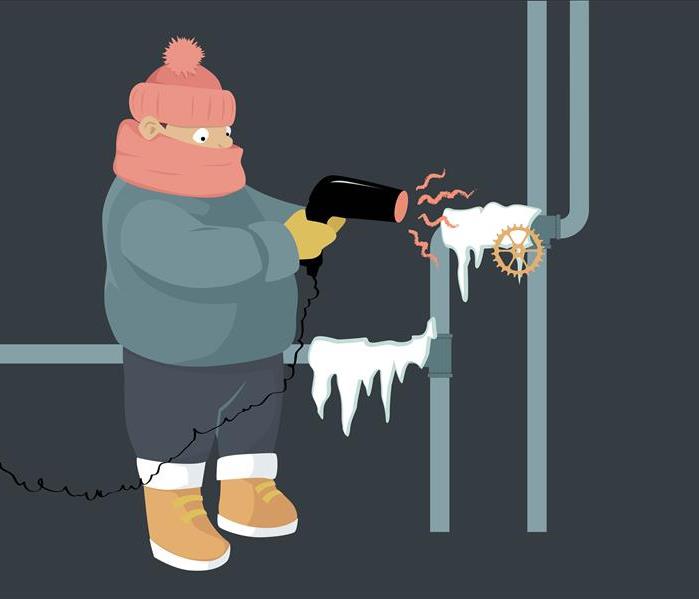 Frozen pipes can cause severe damage to your Pueblo, CO home.
Frozen pipes can cause severe damage to your Pueblo, CO home.
As winter descends upon the charming city of Pueblo, Colorado, residents must prepare for the challenges that come with freezing temperatures. One of the most common and potentially damaging issues during winter is frozen pipes. To help you safeguard your home and avoid the inconvenience of burst pipes, we've put together a comprehensive guide with tailored tips for the unique climate of Pueblo, Colorado.
Understanding the Risk:
Pueblo experiences a semi-arid climate with cold winters, making it susceptible to freezing temperatures that can pose a threat to unprotected pipes. When water freezes, it expands, creating pressure within the pipes and increasing the risk of cracks and leaks. To prevent potential damage and costly repairs, it's crucial to take proactive measures to protect your plumbing system.
7 Steps To Avoid Frozen Pipes
- Insulate Exposed Pipes:
Identify areas where pipes are exposed to the cold and insulate them properly. Focus on pipes in attics, crawl spaces, and exterior walls. Use foam pipe insulation or heating tape to create a barrier against the freezing temperatures, ensuring your pipes remain warm and intact.
- Seal Leaks and Gaps:
Inspect your home for any gaps or cracks that may allow cold air to seep in and affect your pipes. Seal these openings using caulk or weatherstripping. Not only does this contribute to insulation, but it also enhances overall energy efficiency in your home.
- Maintain a Consistent Indoor Temperature:
Keep your home comfortably warm, even when you're away. Setting your thermostat to a consistent temperature helps prevent freezing by ensuring that your indoor spaces remain adequately heated.
- Allow Faucets to Drip:
On extremely cold nights, allow faucets to drip slightly. This continuous flow of water, even at a minimal rate, reduces the risk of pipes freezing by keeping the water in motion.
- Open Cabinet Doors:
In areas of your home with exposed pipes, such as under sinks or in cabinets, open the doors to allow warm air to circulate. This simple step helps maintain higher temperatures around vulnerable pipes.
- Disconnect and Drain Outdoor Hoses:
Before the winter chill sets in, disconnect and drain outdoor hoses. Shut off the water supply to outdoor faucets and store hoses in a sheltered location. This prevents water from freezing in the hoses and prolongs the life of your outdoor plumbing fixtures.
- Schedule Professional Inspections:
Consider hiring a professional plumber to inspect your plumbing system before winter arrives. An expert can identify potential issues, insulate vulnerable areas, and provide valuable advice on protecting your pipes during the coldest months.
Taking these proactive measures will significantly reduce the risk of frozen pipes in your Pueblo, Colorado home, allowing you to enjoy the winter season without the worry of potential plumbing damage. Winter-proofing your plumbing system is an investment in the longevity of your home, ensuring a cozy and stress-free winter for you and your family. Stay warm, stay prepared, and welcome winter with confidence in your well-protected home.
Winter-Proofing Your Home in Pueblo, CO: A Comprehensive Guide to Seasonal Preparedness
11/9/2023 (Permalink)
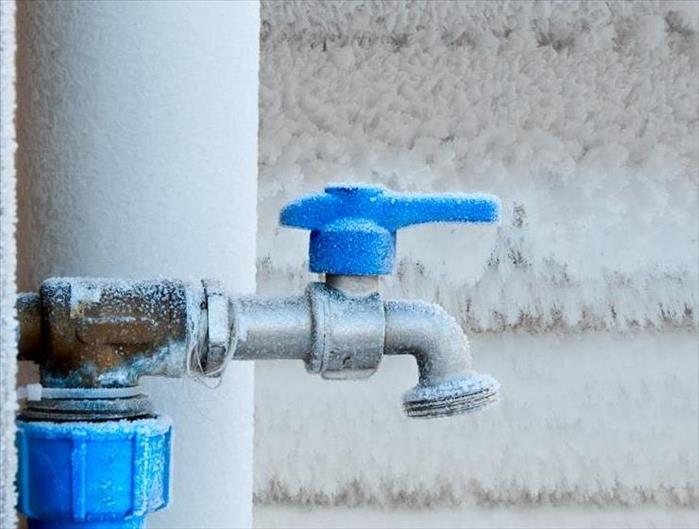 Frozen pipes are a common winter woe in Pueblo, CO.
Frozen pipes are a common winter woe in Pueblo, CO.
As the seasons change, Pueblo, CO, transforms into a winter wonderland, painting picturesque scenes of snow-covered landscapes. However, with the beauty of winter comes the responsibility of preparing your home to withstand the challenges that colder temperatures can bring. In this comprehensive guide, we'll delve into the nitty-gritty details of winter-proofing your home in Pueblo, offering valuable insights and actionable tips to ensure your property remains safe, warm, and damage-free throughout the winter season.
7 Tips To Ensure Your Property is Winter-Proofed
Roof and Gutters: Shielding Your Home from Above
The first line of defense against winter's onslaught is your roof. Inspect it for damaged or missing shingles, as they can lead to leaks and water damage when snow and ice accumulate. Clean out gutters and downspouts to prevent ice dams, a common issue in colder climates. Ice dams can cause water to seep into your home, leading to structural damage and potential mold issues. Ensure that your attic is adequately insulated to prevent heat from escaping and contributing to ice dam formation.
Windows and Doors: Battling the Winter Draft
Drafty windows and doors not only make your home chilly but can also spike your heating bills. Conduct a thorough check for gaps and cracks around windows and doors, and seal them with weather stripping or caulk. Consider upgrading to energy-efficient windows, which can provide better insulation and save you money in the long run. If you have storm windows, make sure they are properly installed to provide an extra layer of protection against the cold.
Pipes: Guarding Against Freezing and Bursting
Frozen pipes are a common winter woe that can lead to costly repairs and water damage. Insulate pipes in unheated areas, such as the attic, basement, or crawl spaces, using pipe insulation. Disconnect and store garden hoses, and shut off outdoor water valves. During extremely cold nights, let faucets drip to prevent freezing. Familiarize yourself with the location of your water shut-off valve in case of emergencies, and consider insulating the valve to prevent it from freezing.
Heating System: Ensuring Warmth and Efficiency
Your heating system is the lifeline of your home during winter, so it's essential to ensure it's in top-notch condition. Schedule a professional inspection to identify and address any potential issues. Change air filters regularly to maintain efficiency and improve indoor air quality. Consider investing in a programmable thermostat to regulate temperatures and reduce energy consumption. If you have a fireplace, have the chimney cleaned and inspected to prevent chimney fires, and use seasoned wood to minimize creosote buildup.
Landscape: Taming the Winter Wilderness
While winter may slow down the growth of your garden, it's essential to prepare your landscape for the colder months. Trim overhanging tree branches that could pose a threat during heavy snowfall, preventing potential damage to your home. Clear dead leaves and debris from your yard to avoid issues when the snow melts. Consider hiring a professional to winterize your irrigation system, protecting it from freezing temperatures.
Emergency Preparedness: Ready for Anything
Winter storms can bring unexpected challenges, from power outages to impassable roads. Equip your home with emergency supplies, including flashlights, batteries, blankets, and a well-stocked first aid kit. Familiarize yourself with local emergency services and have a plan in place for evacuation or sheltering in case of severe weather. Keep a supply of non-perishable food and water on hand, and make sure your family knows what to do in case of an emergency.
Supplies: Stocking Up for Winter Woes
Prepare for winter storms by stocking up on essential supplies. Keep salt or ice melt on hand to de-ice driveways and walkways, preventing slips and falls. Have sand available for added traction. Ensure your snow removal equipment, such as shovels and snow blowers, is in good working order. Consider investing in a generator to keep essential appliances running during power outages.
Winter in Pueblo, CO, is a magical time, but it requires careful planning and preparation to ensure your home remains a haven of warmth and safety. By following these comprehensive tips, you can winter-proof your home and enjoy the beauty of the season without the worry of potential storm damage. From the roof to the foundation, every aspect of your home plays a role in its ability to withstand the winter elements. Take the time to assess and address these key areas, and you'll be well on your way to a cozy and stress-free winter in Pueblo. Embrace the season, and let your home be your sanctuary in the midst of the winter chill.
Top 5 Leading Causes of Residential Fires in Pueblo, CO
10/19/2023 (Permalink)
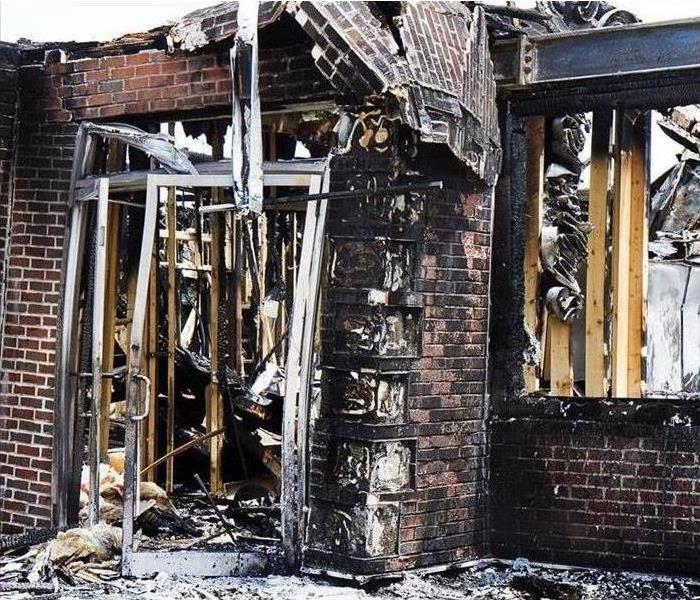 Severely fire damaged home in Pueblo, CO.
Severely fire damaged home in Pueblo, CO.
Residential fires can be devastating, causing loss of life, property damage, and emotional trauma. Pueblo, Colorado, with its unique blend of urban and rural communities, faces its own set of challenges when it comes to fire safety. Understanding the leading causes of residential fires is crucial for both homeowners and local authorities. In this blog, we'll explore the top 5 leading causes of residential fires in Pueblo, Colorado, and discuss how to prevent and protect against these potentially deadly incidents.
Top Five Leading Causes of Residential Fires
- Cooking-Related Fires
Cooking is an essential part of daily life, but it's also one of the most common causes of residential fires in Pueblo and across the United States. Unattended stoves, hot oil, grease fires, and flammable objects near cooking appliances can lead to dangerous situations. In Pueblo, where many households take pride in their culinary skills, the risk is even higher. To prevent cooking-related fires:
- Stay in the kitchen when cooking and never leave food unattended.
- Keep flammable items, like towels or curtains, away from the stovetop.
- Use a timer to remind you of food on the stove or in the oven.
- Install a fire extinguisher in the kitchen and know how to use it.
- Electrical Fires
Faulty electrical systems and overloaded circuits are another common cause of residential fires in Pueblo. Older homes with outdated wiring are particularly susceptible, and the use of modern electronic devices and appliances has increased the risk of electrical fires. To reduce this risk:
- Have your electrical system inspected regularly by a qualified electrician.
- Avoid overloading outlets with too many devices and use surge protectors.
- Replace damaged or frayed cords and wires promptly.
- Upgrade your home's electrical system if it's outdated or not up to code.
- Heating Equipment Fires
In Pueblo, where cold winters are not uncommon, heating equipment plays a crucial role in keeping homes warm. However, heating equipment can also be a significant cause of residential fires, particularly when not properly maintained or used. Wood stoves, space heaters, and furnaces are potential hazards. To prevent heating equipment fires:
- Have heating systems and chimneys inspected and cleaned annually.
- Maintain a safe clearance between space heaters and flammable materials.
- Use screens or doors with wood stoves to prevent sparks from escaping.
- Install smoke detectors and carbon monoxide detectors in your home.
- Smoking-Related Fires
Smoking-related fires are a leading cause of residential fires in Pueblo. Cigarettes, cigars, and other smoking materials, when not disposed of properly, can ignite fires. Moreover, smoking indoors can lead to fire risks, particularly if a smoker falls asleep or becomes careless. To reduce the risk of smoking-related fires:
- Smoke outside the house and use a sturdy, deep ashtray.
- Never smoke in bed or on a couch, as it's easy to fall asleep with a lit cigarette.
- Keep lighters, matches, and smoking materials out of the reach of children.
- Consider quitting smoking for your health and safety.
- Candles
Candles are commonly used for ambiance, relaxation, and religious purposes. However, they pose a fire risk, especially when left unattended or placed near flammable materials. In Pueblo, where the charm of candlelit dinners or prayer is appreciated, it's crucial to use candles safely:
- Always keep candles on a stable, heat-resistant surface.
- Never leave candles burning when you leave a room or go to sleep.
- Use candle holders that can catch dripping wax.
- Consider using flameless LED candles as a safer alternative.
Preventing Residential Fires in Pueblo
In addition to understanding the leading causes of residential fires, there are several proactive steps you can take to minimize the risk and protect your home and loved ones in Pueblo:
Install Smoke Alarms: Ensure that you have working smoke alarms on every level of your home and inside each bedroom. Test them regularly and replace batteries as needed.
Create an Escape Plan: Develop and practice a fire escape plan with your family, including a designated meeting point outside the home. Make sure everyone knows how to escape safely.
Install Carbon Monoxide Detectors: Carbon monoxide is an odorless, colorless gas that can be deadly. Install carbon monoxide detectors to alert you to its presence.
Store Flammable Items Safely: Keep flammable materials, such as gasoline, propane, and paints, stored in a well-ventilated area away from heat sources.
Know How to Use Fire Extinguishers: Make sure you have fire extinguishers in key areas of your home and that you know how to use them in case of a fire.
Regular Home Maintenance: Keep your home in good repair by maintaining electrical systems, heating equipment, and fireplaces.
Residential fires can be devastating, but understanding the leading causes and taking preventive measures can significantly reduce the risk. Pueblo, Colorado, like any other community, faces its unique fire safety challenges, and the responsibility lies with both homeowners and local authorities to ensure the safety of residents. By being aware of the top causes of residential fires and implementing preventative measures, you can protect your home, loved ones, and your community from these potentially deadly incidents. Fire safety should always be a top priority, not only in Pueblo but everywhere.
SERVPRO Is Faster to Any Size Disaster
9/13/2023 (Permalink)
 We arrive Faster to Any Size Disaster.
We arrive Faster to Any Size Disaster.
When disaster strikes you need a restoration team that can begin work immediately. SERVPRO can serve more than 90% of the zip codes in the United States in under two hours, making us faster to any size disaster.
SERVPRO Helps Close Your Insurance Claim Fast
There are several ways SERVPRO helps insurance professionals complete claims fast:
- Locations Near Most Customers
We have over 1,900 locations in the United States and Canada. No matter where your customers in Pueblo, CO, are located, chances are we can get a restoration professional to them in under two hours.
- Always Available
An emergency can happen at any time, so you need a restoration company that is always ready to respond. SERVPRO professionals are available 24/7 to provide immediate assistance.
- Highly Trained Professionals
We have more than 50 years of experience in the restoration industry and all of our professionals are highly trained. Our Institute of Inspection, Cleaning and Restoration Certification-approved training facility provides training for new professionals and franchisees, continuing education and training for insurance professionals.
- One Stop Shop
Most disasters cause more than one kind of damage. Our team is trained to perform restoration for water, fire and storm damage. We can also find and remove mold and provide tarp and board-up service. SERVPRO provides specialty cleaning, air duct/HVAC cleaning and biohazard and crime scene cleaning. Additionally, we can restore documents, remove odors, vandalism and graffiti and clean carpets and upholstery.
- Competitive Advantage
Our quick and effective services help insurance companies also be faster to any size disaster. When you use SERVPRO, you will enjoy lower claims costs, increased customer satisfaction and lower loss ratios. This gives you an advantage over your competition and helps you retain customers.
- Customer Focus
Our goal is to restore your customers to preloss condition as quickly as possible. Happy customers mean fewer headaches for insurance companies.
- Lower Costs
We know that restoring property costs less money than replacing it. We work hard to ensure that all property that can be restored is restored.
- Trusted Vendors
We work with vendors on your behalf so that you don't have to. We only work with the best vendors in the industry so you never have to worry about subpar work.
- Guaranteed Quality
All of our work is backed by a two-year labor and one-year materials warranty. If our work fails to meet your reasonable expectations, we will do it again at no additional cost for up to two years.
- Dedicated Insurance Team
We have a dedicated team whose only focus is keeping our insurance customers happy. We keep the lines of communication open so that any time you have a concern, we are always available to address it.
- Industry-Leading Standards
We make sure our high standards are always met by conducting internal audits. Only franchisees who meet our more than 21 requirements get insurance referrals. SERVPRO takes meeting the needs of insurance clients and their customers seriously.
No matter how large or small the job, we are prepared to demonstrate why we are faster to any size disaster.
Dealing With Roof Damage After a Storm
8/18/2023 (Permalink)
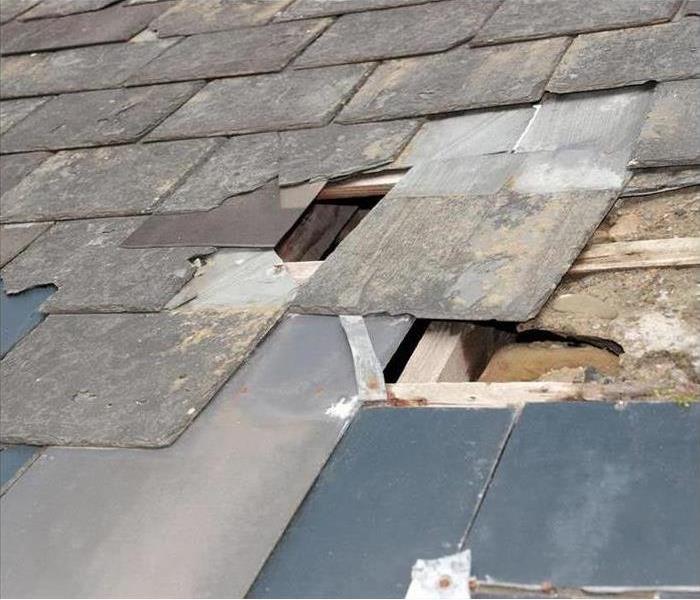 Roof damage after a storm in Pueblo, CO.
Roof damage after a storm in Pueblo, CO.
Severe weather can cause extensive damage to a house, which is why storm preparations are strongly urged by storm remediation experts in Pueblo, CO. One of the most likely damages is roof damage. Roofs are often affected by wind, rain, and flying debris, which is why experts suggest performing inspections after any severe storm.
The Necessity of Remediation After Roof Damage
Whether the cause of damage to a roof was rain, debris, or wind damage, it is necessary to call on a professional service to make any necessary repairs. Leaving your roof in disrepair can lead to more significant damage. Many roofing experts warn of four issues that can stem from a damaged roof.
- Water Damage
When a roof is damaged, the underlayment is exposed. The foundational layer of the roof is not as protective against moisture as the external layers. Therefore, when shingles and moisture barriers are damaged, it is not long before you start seeing water inside your home.
The leaks often start as drips, but those drips will turn into full-blown leaks if you leave a roof unrepaired. Soon enough, you will have numerous pots and pans collecting water during storms.
- Mold
Mold is typically a natural side effect of moisture. No matter how clean your home is, mold spores are everywhere. If these spores locate a sustainable water source, they land and multiply. Within two days, you can have a colony requiring expert removal.
The problem with a damaged roof is you do not always notice an issue until it is too late. Not all leaks are noticeable, mainly if they occur in an attic space and are minor. Because mold can grow so fast and not all leaks are noticed, inspecting your home after every rainstorm is crucial especially severe ones.
- Structural Damage
Remediation is crucial when a roof is damaged because the damage can result in structural issues. When problems get ignored, a minor roof repair can lead to ample moisture and rot problems later. Water is no friend of wood, which is why so much effort is put into waterproofing your home.
The sheathing and beams that make up your roof and connect your walls are vulnerable to moisture. Too much exposure can lead to rot, mold, and decay. Eventually, with unmitigated exposure, holes will emerge in the structure, and beams will fail.
- Safety
The primary reason for remediation after storm damage is safety. When the structure of a home is called into question, the only appropriate response is to repair it. A damaged roof can evolve from water damage to mold damage and worse. Keeping your family safe means taking the right actions in a timely manner.
Roof damage is a significant possibility of severe weather. The damage can range from minor to severe, but regardless of the degree of the initial damage, quick response to repairs is necessary to maintain the security and safety of your home. Remediation experts are your best resource for such maintenance, especially if there is any level of expectation of danger or uncertainty.
Flushing Your Water Heater: Six Simple Steps
8/4/2023 (Permalink)
 Flushing a water heater.
Flushing a water heater.
The water heater in your Pueblo, CO, home is a hard-working appliance that ensures you have pleasantly warm water for showers and hot water for washing clothes and dishes. If you're like most people, you probably don't know how much you love this appliance until it isn't working correctly.
The first time you're forced to rush through a cold shower, the heater will jump to the top of your home maintenance list.
The Importance of Flushing the Water Heater
As water flows through the heating tank, sediment and buildup collect and clump together. This takes up space in the tank, reducing the amount of water that flows through. It reduces efficiency and eventually causes damage to the tank. Flushing the heater prevents several common issues:
- Total loss of heated water
- Inconsistent hot water
- Decreased water pressure
- Leaks from the water heater tank
- Smelly water from bacterial growth
- Banging from the heater
The good news is that you can perform a water heater flush every year with minimal inconvenience and a few tools that you probably already have on hand.
Step 1: Shut Off the Power
Whether you have an electric unit or a gas-powered appliance, you need to shut the unit down completely. A gas appliance probably has both gas and electricity to shut off. This step is crucial to your safety and the safety of anyone else in your home.
Step 2: Open the Hot Water Line and Turn Off the Cold Water
When you turn on the hot water, the water won't be hot, but the flowing water prevents air bubbles from forming in the system. Shutting the cold water valve to the heater stops water from getting into the unit while you're working.
Step 3: Attach a Hose to the Heater Spigot
Look at the bottom of the tank or heater unit for a faucet like a spigot used on the exterior of your house. Place a bucket under the spigot and attach a garden hose to contain the outflowing water. Make sure your bucket or container is large enough to hold all of the water that comes out of the heater.
Step 4: Drain the Heater Tank
Turn on the spigot and let the water drain out. Dark-colored water full of sediment is an indication of trouble. If solid chunks are coming through the hose, you should contact a professional to check for more significant trouble.
Step 5: Run Cold Water Through the Unit
When you turn the cold water on, clean water flows through the unit, carrying any residual sediment out of the heater. Flush the tank for a few minutes, looking for clean, clear water from the hose. Turn the water off before removing the hose from the spigot.
Step 6: Power the Heater Up
Once you've finished flushing the water heater, clean up your supplies and reset all of your water lines. Close the hot water faucet and turn on the cold water supply. Release the pressure valve on the tank and turn the gas and electricity on.
If you are concerned about water damage or have other questions about this process, reach out to Pueblo, CO water damage professionals. Prevention is nearly always less expensive than cleanup, repairs, and replacement.
6 Things You Should Know About Water Damage
8/4/2023 (Permalink)
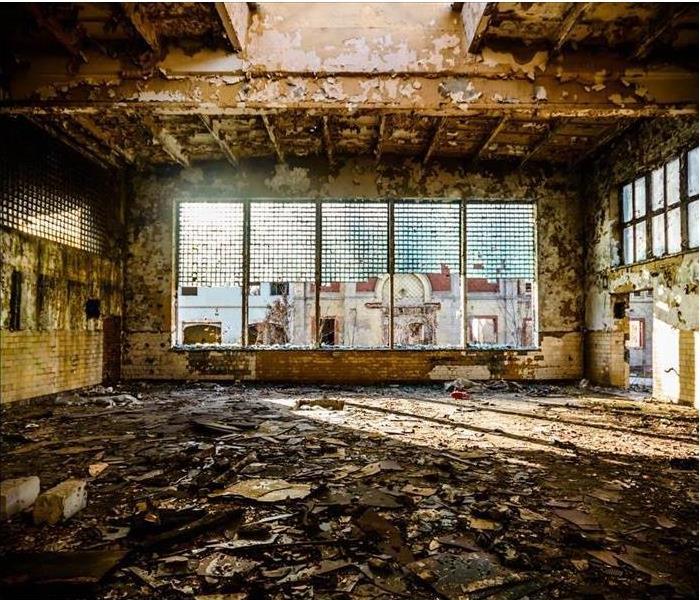 Understand the causes of water damage and minimize damage in your Pueblo, CO property.
Understand the causes of water damage and minimize damage in your Pueblo, CO property.
Water damage caused by a pipe burst, flood, or storm is a common challenge for homeowners. The more you know about water damage, the better equipped you will be to deal with it if it occurs in your home.
What You Should Know About Flooding and Other Water Damage
About one in 50 homeowners file a claim related to freezing or water damage every year. These are some of the most important facts to know about this common problem.
- The Longer You Wait, the More Damage You Will Have
It is critical to dry out wet property within 24 to 48 hours. After this point, mold may begin to grow. Wood may rot. Water from clean sources, such as a water line break, may become contaminated. Quickly and completely drying property is the best way to reduce the total amount of damage done. If you are unable to dry out your property yourself, you may want to contact a water remediation company in Pueblo, CO, to assist you.
- Water Damage Is Often Avoidable
You can't control the weather, but you can often take steps to mitigate potential flood damage by installing a flood control system in your home, keeping your roof and windows up-to-date and in good repair, and making changes to your landscaping. Additionally, you can avoid water damage from broken plumbing or appliances with regular inspections and maintenance.
- Some Water Damaged Property Can Be Restored
Some water-damaged items, such as food, carpet pads, drywall, and other difficult-to-dry or decontaminate items need to be replaced. However, other materials can be dried out and restored if you act quickly.
- It May Be Covered By Insurance
Most homeowners' policies cover water damage from a sudden and accidental discharge, such as that from a pipe burst. Water that enters through an opening in the roof caused by wind damage may also be covered. Flood damage is usually excluded from homeowners' policies, but may be covered if you have a separate flood policy.
- Some Types of Water Damage Are Not Do-It-Yourself Projects
A small amount of water from a supply line leak or a washing machine overflow may be safe to clean up on your own. However, water from flooding or that contains sewage or other contaminants requires protective gear and training that most homeowners do not have.
- Avoid Walking or Driving in Floodwater
Walking or driving in floodwater is hazardous for multiple reasons. First, it can be difficult to judge how deep floodwater is or how swiftly it is moving. People and vehicles can easily be swept away by water they thought was safe. Second, floodwater may contain sewage and other contaminants. Third, the storms that cause flooding often result in downed power lines, which can make walking through floodwater an electrocution hazard. Similarly, water that covers electrical outlets in a home may not be safe.
Most homeowners will encounter some type of water damage. Educating yourself on facts about water damage from a pipe burst or other source can help you stay safe and minimize property damage.
7 Ways To Reduce Kitchen Fire Risk While Cooking
8/4/2023 (Permalink)
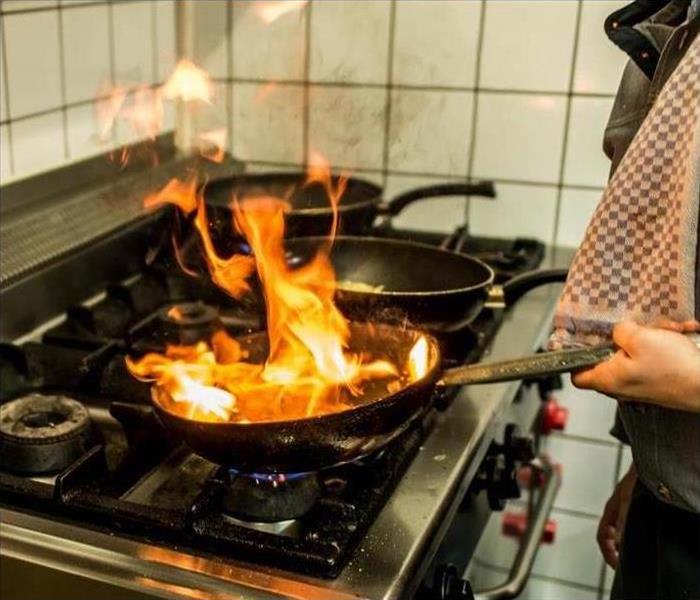 Follow These Tips to Reduce Kitchen Fire Risk While Cooking in your Pueblo, CO property.
Follow These Tips to Reduce Kitchen Fire Risk While Cooking in your Pueblo, CO property.
After a long day, kitchen safety may not be at the top of your mind. You just want to prepare a meal, sit down and eat. However, most residential fires begin in the kitchen. Fortunately, there are some simple tips for significantly reducing your risk of a cooking fire at your home in Pueblo, CO.
Limit Your Risk of Fire but Be Prepared for Fire Damage
- Watch Cooking Food
One of the most essential kitchen fire safety measures is to stay in the area while food is cooking. A fire can begin in mere seconds, which means it could become out of control before you even realize something is burning. If you need to leave the kitchen, recruit someone to watch it.
- Have a Fire Extinguisher Within Reach
It's always helpful to keep a fire extinguisher within reach in case something bursts into flames. Extinguishing the fire within seconds can mean the difference between minor to no damage and total devastation. Also, make sure everyone knows how to operate the fire extinguisher properly.
- Learn the Proper Fire Extinguishing Techniques
No two fires are alike. Some methods of extinguishing a specific kind of fire can actually make another type of fire worse. Keeping a pan lid over a fire will typically extinguish it. One of the most important tips to remember is to NEVER put water on a kitchen fire, particularly a grease fire, as it can make it spread fast and harm you in the process.
- Be Careful With Hot Grease
Grease fires can be the most hazardous type of kitchen fire. Cooking oils can present significant hazards if used at temperatures above their smoke point. These oils begin smoking at different temperatures, so it's essential to be aware of the line and not cross it when cooking.
Also, don't let the hot oil and grease near flammable materials (including trash in your trash can) until they are completely cooled.
- Keep Emergency Phone Numbers Close
There's always somewhat of a risk that a fire could break out in your kitchen, so just as you keep a fire extinguisher close by just in case, it's also good to have emergency phone numbers within reach. Post any numbers you may need in case of an emergency in the kitchen for the whole family. These numbers include the direct numbers for your fire and police departments, as well as the numbers for fire damage restoration professionals and friends and family who should be notified.
- Maintain Your Smoke Detectors
Many people forget or avoid maintaining their smoke alarm system. If something starts smoking or a blaze begins, a well-maintained smoke detector will quickly alert you. The most important thing is to replace each unit's batteries at least twice a year and test the devices to ensure they're working correctly. You also need to keep them clean and dust-free.
- Be Mindful of Flammable Materials Nearby
While you're cooking, it's essential to remain mindful of flammable materials near hot appliances and food. Keep long sleeves rolled up, and don't wear baggy clothes while cooking. Also, be aware of towels, curtains, papers and other combustible materials such as aerosol cans and lighters.
A fire in your kitchen can get out of control quickly. Keep your family and home safe by following these tips for cooking safely.
Common Problems That Require Commercial Water Repair
7/31/2022 (Permalink)
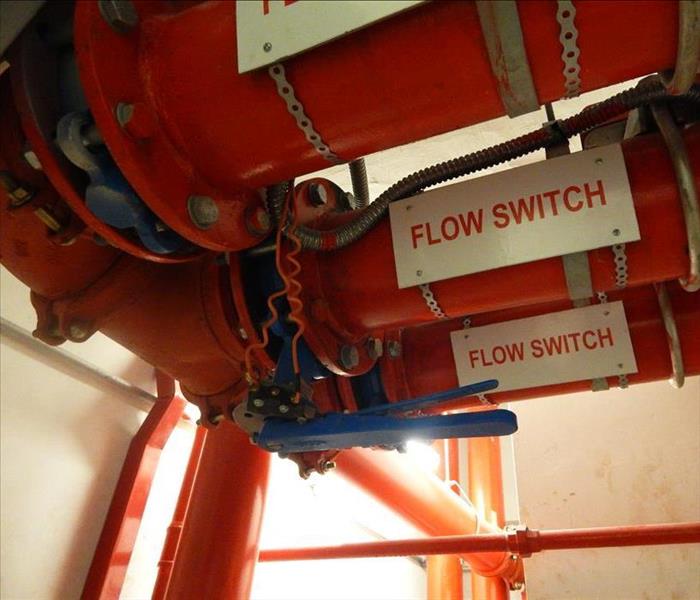 A broken pipe can cause severe water damage.
A broken pipe can cause severe water damage.
Commercial properties share some of the same water damage risks, such as a broken pipe, as residential properties. However, commercial properties also have unique risks because of the size, scale and nature of their operations. These are some of the most common water damage issues in commercial buildings.
Common Commercial Water Repair Issues
Commercial property owners face several common issues that can lead to water damage:
1. Clogged Drains
Because of the large volume of waste passing through drains, commercial properties frequently have issues with clogged drains. Additionally, employees and members of the public may not take the same care when using commercial plumbing systems, leading to additional problems due to objects and substances being flushed down toilets and dumped into sinks that shouldn't be. Clogs may lead to flooding from sink and toilet overflows that require cleanup by a water restoration service in Pueblo, CO.
2. Water Temperature Issues
Commercial water heaters are large and complicated. This makes them prone to deterioration which can lead to issues with water temperatures. Depending on the severity of the problem and the nature of the operations, this could cause minor inconveniences, such as a lack of warm water in the bathroom sink, or major problems, such as water not being kept at the required temperature for industrial processes or regulations.
3. Pipe Damage
Many commercial buildings contain hundreds of miles of pipes that carry thousands of gallons of water. A broken pipe can cause significant property damage and service disruption.
4. Leaks
The sheer number of pipes and fixtures in many commercial buildings can make it difficult to avoid leaks, particularly if regular maintenance schedules are not followed. In addition to sinks and toilets, industrial equipment and sprinkler systems may require pipes and supply lines that cause leaks. Damaged roofs and leaky foundations can also be a source of water issues.
5. Sewage Smells
Dry pipes, clogs and other issues can cause sewage smells to permeate a commercial building. When this happens, businesses may lose customers or be forced to shut down while the source of the problem is investigated and resolved.
6. HVAC Problems
HVAC units can cause water damage due to frozen evaporator coils, clogged drains and improperly connected pipes. Many HVAC problems can be avoided with regular maintenance and inspection.
7. Vacant Buildings
Vacant buildings do not use water in the same way that occupied buildings do; however, when a problem occurs it may not be detected for a long time. Water sources to vacant buildings should be shut off and buildings should be regularly inspected for leaks.
8. Boiler and Machinery Malfunctions
Boilers and other commercial equipment that use water can malfunction leading to leaks, burst pipes and other types of water damage. This equipment must be properly inspected and maintained to avoid problems.
9. Sewage Backup
Sewage backups can be caused by clogs and heavy rainfall. While this type of damage is not as common as other types, it can be particularly severe because of the need to clean and sanitize the impacted areas.
A broken pipe can happen in any type of building. However, commercial buildings face unique challenges that require vigilance from building owners.
First Aid Tips for Burns in the Workplace
7/26/2022 (Permalink)
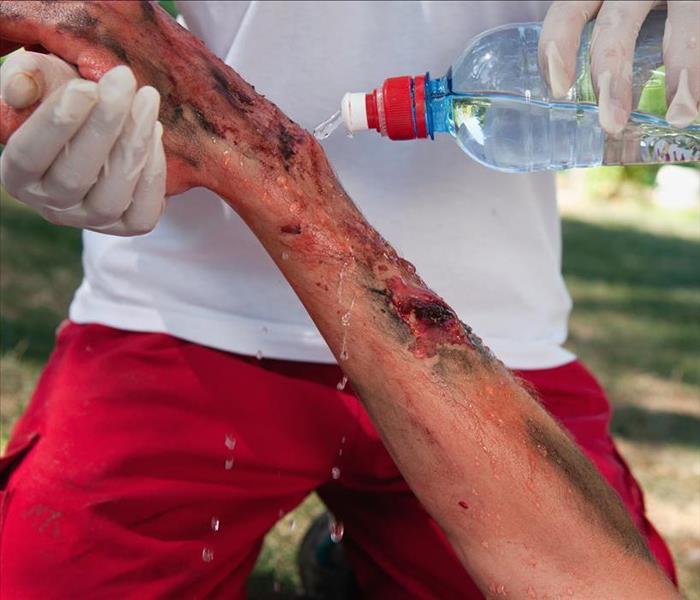 Learn first aid for burns.
Learn first aid for burns.
If a fire occurs in your Pueblo, CO, commercial building, your first concern should be the safety of your employees. Before you assess any fire damage, you should see if any of your workers need first aid.
Burn First Aid Tips for the Workplace
Burns are a common cause of injury during a fire. If an employee suffers a burn, you must determine how severe it is. A major burn requires emergency medical intervention. A major burn:
- Swells quickly
- Is at least 3 inches or 8 centimeters in diameter
- Encircles a leg or arm, or covers the groin, buttocks, feet, face, hands or a major joint
- Appears charred, or has brown, black or white patches
- Goes deep into all layers of the skin
- Makes skin leathery and dry
Treating Major Burns
If you suspect that an employee has a major burn, call 911 immediately. While you wait for first responders to arrive, you should raise and cover the burn. If possible, lift the wounded area so it is above the victim’s heart. Then put a clean cloth or gauze on top of the burn.
Since burns often lead to swelling, you should remove any tight belts or jewelry that the victim is wearing. Necklaces, in particular, could choke the victim if the neck starts to swell.
You should also keep a close eye on the victim to ensure he is still breathing. If you do not see or hear his lungs inflating, perform CPR immediately. Burn victims can quickly go into shock, as well. Signs of this condition include shallow breathing, clammy skin and a weak pulse.
Finally, keep the victim away from further harm. If possible, remove him from the source of the fire. Do not take off any clothes he is wearing, as doing so could make the damage worse.
Treating Minor Burns
An employee could also suffer a minor burn whenever fire damage occurs to your property. You should be able to treat this burn with basic first aid. Start by putting the burn under cool running water for approximately 10 minutes. If the burn is on the victim’s face, use a wet, cool cloth to ease the pain.
If blisters start to develop, do not pop them. They help prevent infection. If a blister does burst, apply water and an antibiotic ointment to the wound.
After the burn has cooled, rub a lotion onto the injury. Ideally, the lotion should contain cocoa butter or aloe vera. The lotion relieves pain and hydrates the skin.
Finally, place a clean bandage on top of the burn. Be sure to wrap it loosely so it does not put too much pressure on the burned skin. The victim can also take over-the-counter pain medication if necessary.
Once you have treated all employee injuries, you can move on to the next step of the recovery process: restoring your property. Fire damage cleanup professionals can remove charred items from your building and reconstruct any destroyed walls or roofs.
Immediately after a blaze, you may have to administer burn first aid to one or more employees. By following the above steps, you can limit how much harm the burns cause.
The Importance of Timely Flood Damage Mitigation
7/20/2022 (Permalink)
 Roof damage due to a storm can cause flooding and damage to your home.
Roof damage due to a storm can cause flooding and damage to your home.
Having the security of flood insurance after a major storm hits Pueblo, CO, is a relief. If the damage it causes is widespread throughout your area, though, it may be a while before your adjuster arrives to assess your home. There are many reasons not to wait on your provider's representative before starting mitigation.
Reasons Not To Wait for the Flood Insurance Adjuster To Arrive
Under normal circumstances, insurance adjusters are tasked with making sure the information provided by clients on claims is accurate. If your home has extensive damage, though, it may only get worse if you wait to start the remediation until after the adjuster visits. Quick action is necessary for several reasons.
Before any work can be done, you must know the full extent of the problem. The flood damage mitigation experts you hire to fix what's wrong with your home are trained to provide an accurate assessment of the issue. They go beyond the surface for a thorough investigation of potential issues:
- Contamination level
- Air quality
- Structural integrity
- Saturation extent
- Secondary damage
Adjusters list all the problems they see but certified mitigation experts understand what the actual cleanup process entails. Thus, they know the specific problems to look for and are likely to catch something that the adjuster might miss. They can also take pictures and provide an itemized list of work that needs to be done to aid the adjuster in getting an accurate picture of the original state of your home after the flood.
Just like any other liquid, water continues to cause problems as long as it's someplace it's not supposed to be, and if you neglect to act in a timely manner, your flood insurance policy may not cover extended damage. Even if you are able to pump the majority of the standing water out of your home, the excess moisture that inevitably stays behind is still seeping into your flooring and your baseboards. The water that is already in your drywall will continue to expand until it's completely cut out. The faster your response, the more likely it is that some materials can be salvaged.
Another common issue that arises with unmitigated water damage is mold growth. You may think that you have plenty of time to start cleanup, but the truth is that mold damage can occur within as few as 24 hours after the initial flood happens. This is especially true of the spaces in your home that may already be prone to fungus growth, such as the bathroom and laundry room. Waiting for an adjuster to survey your house only paves the way for mold to exacerbate the issue.
Your flood insurance provider is certainly one of the first calls you should make when your home is flooded. If the damage occurs as a result of a storm, though, adjusters in your area may be very busy and thus delayed. Don't wait to start the cleanup process. Your mitigation team can provide the thorough assessment that your insurance company needs while stopping damage in its tracks.
The Facts About Thunderstorms
7/19/2022 (Permalink)
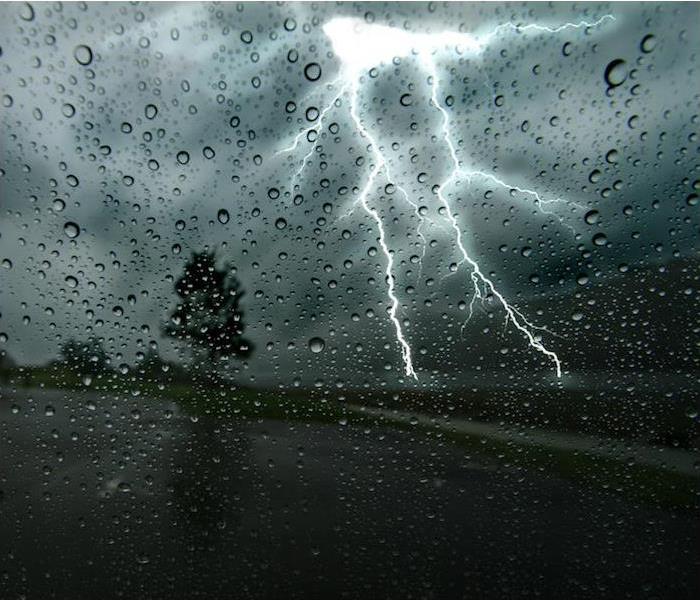 Thunderstorms can pop up at any moment.
Thunderstorms can pop up at any moment.
When you think about severe weather, hurricanes and tornadoes may come to mind. If you’re thinking globally, things like cyclones and monsoons may also be thought of.
But you may forget all about thunderstorms.
Thunderstorms occur so frequently that we often fail to think of them as dangerous, which can be a problem in and of itself. While many thunderstorms pass without incident, there are those that do not—and between high winds, lightning, hail, flooding and other issues that thunderstorms can cause, there are many ways that the weather can turn dangerous quickly.
By definition, thunderstorms are any storm that involves thunder. By extension, that also means they include lightning, since the two always go hand-in-hand, even if you don’t see the lightning.
Most of these storms are inconsequential, but they can quickly turn severe in the right conditions. Severe thunderstorms are defined as storms that contain hail that is one inch or larger and straight-line winds of 58 miles per hour or more.
Why Thunderstorms Are Dangerous
- Damage and injury from lightning strikes.
We mentioned above that lightning always accompanies thunder. It’s also incredibly dangerous, and it is reported that lightning strikes cause around 300 injuries every year. Bodily harm is one key danger, but lightning strikes can also damage property, both directly and indirectly through things like trees falling on homes after a strike.
- Property damage due to hail.
You probably know what hail is, and you may consider it a danger to your car. But it’s also a danger in other ways. These ice pellets vary in size from tiny to very large. Their size, as well as how quickly they fall, contribute to how dangerous they are. Large hail, propelling quickly, can damage your roof and siding, which may lead to a leak and resulting water damage.
- Harm from flash flooding.
Flash floods can occur any time there is heavy rain for a plethora of reasons—even if storm drains back up or small ditches become filled with water, heavy rain can quickly turn these things into a life-threatening flooding scenario. This type of flood earned its name; they literally occur in a flash, endangering people around the area. If flash flood conditions are present, stay off the road.
Thunderstorms are dangerous and can cause significant damage to homes or commercial spaces in Pueblo, CO. If you have damage due to a thunderstorm, you can count on us to help. C
We’re Ready if You Need Home Restoration Services in Pueblo
7/19/2022 (Permalink)
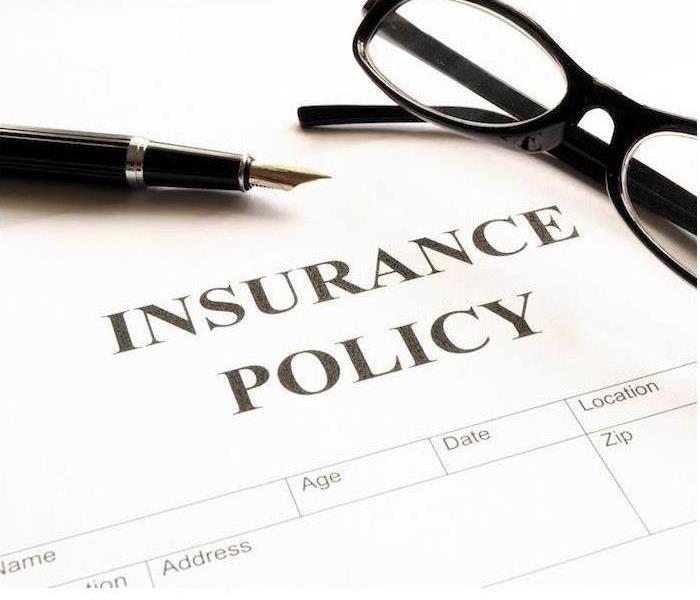 We’re Ready if You Need Home Restoration Services in Pueblo, CO.
We’re Ready if You Need Home Restoration Services in Pueblo, CO.
No two home damage claims are the same—even the claims resulting from the same thunderstorm or hail event can be very different.
But all these claims actually have one thing in common. Want to guess what it is?
No matter what kind of damage your home suffers, getting the restoration process started as quickly as possible is vital to making sure your home can be restored quickly and efficiently to its original state.
Time is of the essence in any restoration emergency, but it’s essential when your home is damaged by water. You can notice the effects of water damage within a few hours, including the tell-tale musty odor that signifies the beginning of a mold problem. Within a few days, wood will start to warp, too.
Why Homeowners Need Restoration Services
Homeowners insurance claims include things like severe weather issues, such as wind, hail and rain. While natural disasters can cause damage to more than one home in a city or neighborhood, accidents and appliance malfunctions are also common reasons individual homeowners need restoration help.
Your SERVPRO Team Is Here 24⁄7
Because we understand that it’s vital to get help for your home as soon as possible, we’re available when you need us for emergency restoration services.
That means you can call us on nights, weekends and holidays if you need our assistance. We’ll be here to answer your questions and get your restoration process started.
There are other good reasons to choose SERVPRO, too. Here’s what makes us different.
3 Reasons to Choose SERVPRO
- Our teams are staffed by expert technicians.
We have technicians who are highly trained experts. They hold valid certifications in their fields and will bring their wealth of knowledge about water damage to your home.
- Our teams have access to the best restoration technology.
Our relationship with a trusted national partner like SERVPRO means we can access the latest and greatest in restoration technology. When combined with our technical expertise, that technology gives you an edge when you work with our team.
- We’re a locally owned business.
We want to serve our community and help our friends and neighbors get great results when they need us the most.
If your home is damaged due to fire, water or any other cause, you can always count on us for restoration assistance. We have teams in Pueblo, CO, who are available 24⁄7 in the event of an emergency.
Creating a Fire Escape Plan for Your Home
6/24/2022 (Permalink)
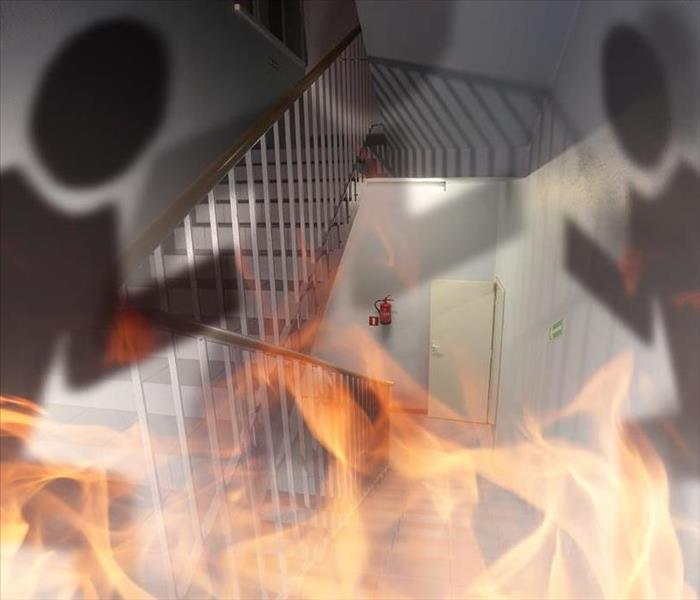 Create the best Fire Escape Plan following the Tips of our Professionals.
Create the best Fire Escape Plan following the Tips of our Professionals.
While no one hopes to experience a fire in their home, it’s important to be prepared ahead of time. From carrying homeowners’ insurance to knowing which local fire restoration company to call, you need to have a plan that outlines what to do in the event of a fire. If your home in Pueblo, CO, catches fire while you and other household members are there, do you have a plan for a safe exit? Now’s the perfect time to come up with a fire escape plan. Here’s what you need to know.
Developing a Fire Escape Plan
Creating an escape plan should be done collaboratively with everyone in the household, including children. Consider the following tips:
- Walk through the home making note of all possible exits from the house, including doors and windows.
- Your plan should also account for exiting the home from upper floors.
- Create a map of the home with exits and smoke alarms for young children.
- Make sure your routes for escape are clear and free of obstacles.
- Confirm that doors and windows are easy to open.
- Determine an outdoor meeting place that everyone will head to. It should be a safe distance from your house and marked on your map.
- Your plan should designate an official assistant for helping infants, the elderly, and anyone with limited mobility escape. Indicate a backup in the event the first designee is not home during a real emergency.
Coming up with a plan allows you to take stock of any changes that need to be made to help everyone exit the building quickly and safely.
Testing Your Plan
Practice makes perfect, and you’ll need to test your plan to see if it’s effective. Consider these tips for testing your fire escape plan: Practice your fire plan at different times of the day, including the nighttime. Commit to fully exiting the building, making accommodations for those whose mobility is limited.
While you don’t want to frighten young children, it’s important to test your plan when they’re asleep. This lets you know if your smoke alarms are effective at waking them up. Your escape plan may need to designate someone responsible for waking them up.
Test alternate escapes
In a real home fire, the quickest route may not be the safest. Everyone should practice getting low to simulate crawling under smoke. Keep ladders near windows for safe exits from the second floor.
Planning for No Escape
Your fire preparation plan should also account for a situation where home escape isn’t possible. Fire or smoke may block all exits. Come up with a plan for isolating family members from fire or smoke. This includes closing doors, sealing openings, and covering vents to limit the spread of fire and smoke. Household members should also know how to open windows to let in fresh air. Be sure to include flashlights or other devices to direct firefighters to your location.
As a responsible homeowner, you want to make sure you and your household are prepared for a fire. A well-developed and practiced fire escape plan is your best chance for survival. Accidents can happen at any time of the day, so it’s important to practice executing your plan at various times and under different circumstances.
3 Examples of Category 3, or Black Water, Damage
6/17/2022 (Permalink)
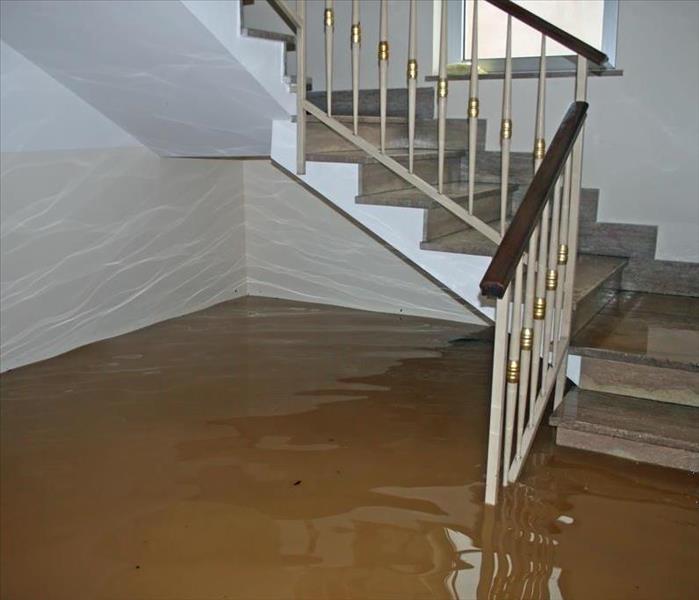 Learn More about Water Damage following our Tips.
Learn More about Water Damage following our Tips.
Water damage happens in many ways and can range from inconvenient, such as a warped countertop, to severe, such as multi-story flooding. It's understandable that in some cases the damage can be addressed by the homeowner, but in other situations, such as black water contamination, the damage requires the services of sewage cleanup experts. As a homeowner in Pueblo, CO, here's what you need to know about this extreme water contamination.
3 Examples of Category 3, or Black Water, Damage
The hazards you can expect from the three categories of water damage range from Category 1 water damage that originates from clean water to Category 3 which contains toxic substances, such as bacteria, pesticides, chemicals, and raw sewage. This type of contamination leads to extensive damage and risk. It can also happen in a variety of situations.
1. Outside Flooding
Storms and heavy rain may cause nearby lakes and rivers to flood. It can raise the water table, leading to flooded basements and ground-level homes. When this happens, the rising water carries feces from rodents and neighborhood pets. It also picks up chemicals from pesticides, garbage, and landscaping treatments.
When this contaminated water flows through your home, those toxic substances are readily absorbed by the structural components of your home as well as by your furnishings and belongings.
2. Sewer Backups
There are several potential causes of sewer backups: clogged and blocked sewer pipes, damaged and aging pipes, tree roots in the system, and major blockage in the municipal lines. As soon as sewage emerges from your toilet, bathtub drain, or sink drain, it's important to reduce the risk to you, your family, and your home.
Don't touch the dirty water and close off the area, so pets, children, and other adults don't move in and out of the area. As water evaporates, many of the chemicals and contaminants from the water will get into the air.
It's important that professionals resolve this situation as quickly as possible. Water damage cleanup and restoration pros have the proper protective equipment and commercial cleaners to remove heavy metals, pesticides, bacteria, chemicals, urine, and raw sewage safely and thoroughly from your home. These technicians have extensive training to protect them and your home from the hazards carried by this contaminated water.
3. Standing Clean Water Flooding
Flooding in your home may originate from a source of clean water. Maybe the bathtub was left running and overflowed. A pipe under the kitchen sink may burst, or a damaged clothes dryer could cause flooding. Initially, this water damage falls into Category 1 and Category 2 contamination, but when that water is allowed to sit for more than 24 hours, the damage will increase until you have black water contamination. This happens because the sitting water absorbs chemicals from the drywall, carpeting, and other materials.
Black water, or Category 3, damage is the most dangerous type of water contamination and should only be cleaned up by professionals with the appropriate protective gear, equipment, and treatments. Your top priority should be ensuring the safety of your family and reducing damage to your home.
How To Identify Contaminated Water and Clean It Up
6/13/2022 (Permalink)
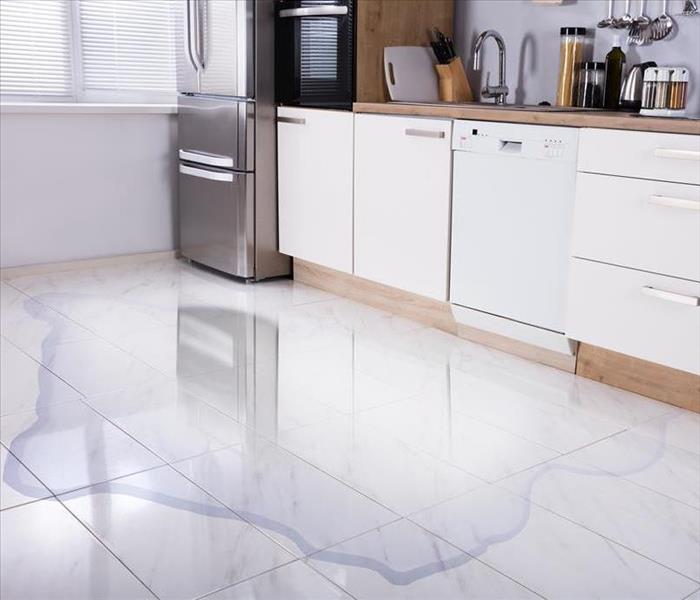 Our specialists can help you with the Water Cleanup.
Our specialists can help you with the Water Cleanup.
When a home in Pueblo, CO, experiences water damage, it’s vital to take care of the issue as soon as possible. Prior to jumping into cleanup, it’s also essential to know whether it is clean or contaminated water. The latter requires additional safety precautions and is known to spread more quickly.
Is It Black Water?
The IICRC has determined three types of water categories.
Clean:
Considered sanitary, this originates from a source that poses no substantial risk. This type may come from a water supply line, sink or bathtub overflow, or rainwater. It is typically easy to clean and won’t cause long-lasting damage if mitigated quickly.
Grey:
This category of water may have some contamination but is still considered relatively safe to deal with. Sources that create this type of water damage include urine-only toilet overflow, malfunctioning appliances or a leaking aquarium. During cleaning, an anti-microbial spray will be needed to ensure affected items are disinfected properly.
Black:
This highly contaminated water has the potential to have toxins, pathogens, bacteria, chemicals and microorganisms that require added layers of safety when handling. Since it often contains sewage, underground water or waste line backflow, it is best to leave the cleanup to a water damage mitigation and restoration company.
Prevent the Spread
Even if the problem starts as a Category 1, that doesn’t mean it will stay that way. Any water left standing presents a prime situation for mold to start to grow. Since porous materials wick up moisture, even a small amount of water may be slowly causing hidden issues.
That also means that belongings may slowly be sitting in water, possibly causing irreversible damage. After determining the source of the water, cleanup should begin as soon as possible. The following steps should be taken to minimize additional damage:
- Find the source of the water problem and contain it. This may require turning off the main water valve if it is a broken pipe.
- If the situation is being caused by nature, homeowners will have to wait for the water to subside. In the meantime, belongings that haven’t been affected yet should be moved to higher levels.
- Once the source is resolved, wet belongings that can be relocated should be moved to a safe, secure place to dry out thoroughly.
- The next step is to begin removing the water. The faster that happens, the better the chances of minimizing the damage.
- Once water is removed, the affected area needs to be thoroughly dried. Fans and dehumidifiers should be used to speed up the process.
- After several days of drying, depending on the extent of the damage, cleaning, sanitizing and deodorizing can begin.
- The final step is restoration. That may require replacing the carpet, drywall, ceiling panels and other structural components of the home.
While any unwanted water in a home is unwelcome, contaminated water poses additional issues. Knowing the types of water classifications and their sources makes it easier to know when a professional should be called for help. No matter the source, speedy cleanup and swift action are needed to keep it from spreading.
4 Critical Steps for Roof Damage and Water Damage Mitigation
5/26/2022 (Permalink)
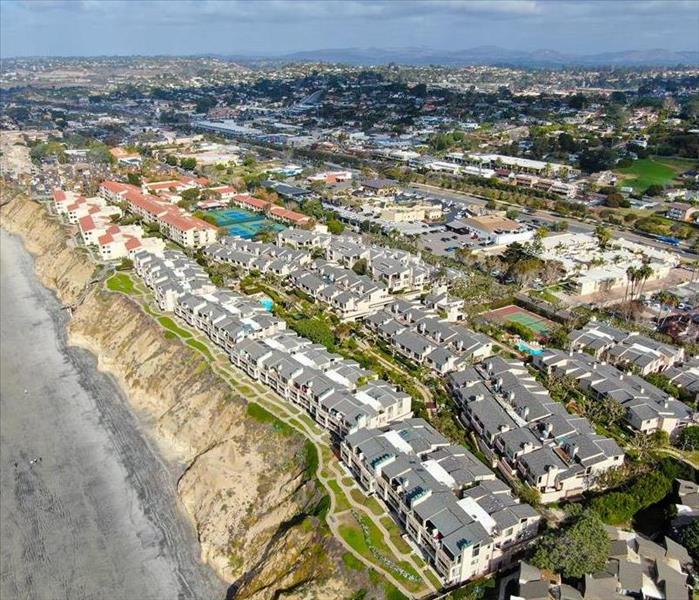 Follow these Steps and avoid Water Damage in your Property.
Follow these Steps and avoid Water Damage in your Property.
The roof over your home is in a precarious location. It often takes the brunt of everything from high winds to heavy rains to hail and snow. It is not surprising that roof damage is common after a powerful storm. When this happens, your home in Pueblo, CO, is even more exposed to the elements and quick action needs to be taken. Failure to act could result in another storm sweeping in and pouring water onto the interior of your residence.
To secure your home after an extreme weather event, it is important to get professional help. Working with a storm damage restoration company in your area is a smart choice, particularly if you have gaps in the roof or extensive damage to shingles. A local franchise can arrive quickly and begin to secure your exposed home with appropriate actions.
Important steps to avoid Water and Roof Damage.
1. Roof Tarping Services
The first step could be putting a waterproof barrier in the form of a tarp over your house. This will prevent additional wind damage and keep moisture from ruining carpeting, furniture, personal belongings and insulation. It will place a barrier over your home until more permanent repairs can be made. Erecting a tarp over a home is an inherently risky job so it is best left to professionals who will follow critical safety protocols and use suitable equipment.
2. Roof Damage Inspection
When looking at the roof after storm damage, trained workers will make sure everyone in the home is safe. This could include asking your family to vacate the premises for a time. Other steps could include making sure electrical hazards are addressed and contacting the power company to repair downed power lines. The initial roof inspection will be done from the ground for safety purposes. Only when the roof is deemed safe, will the inspection proceed to go up on the roof.
3. Restoration and Rebuild
Wind damage to shingles and the tearing off of roof boards will require construction services. The goal is to restore the roof to its original condition so it can once again protect your home during extreme weather. A successful job includes completing the roof mitigation on time and within budget. It allows your family to move back into the home and feel secure. A quality construction contractor will coordinate with your insurance company to expedite the claims process.
4. Water Damage Assessment
As roof repairs proceed, workers will also need to inspect the home for signs of water damage. Any standing water will need to be removed from the home and drying equipment will be necessary to remove excess moisture. The severity of the damage determines the most appropriate steps to take. If structural damage has occurred, a remediation and construction plan will be communicated to the homeowner. You should be informed of all steps along the way, and you will not need to be in the home at all times while repairs are being made.
It is an unfortunate event when roof damage exposes your home to the elements. With the proper steps, though, your home can be restored to its original condition.
Smoke Cleanup Methods
5/12/2022 (Permalink)
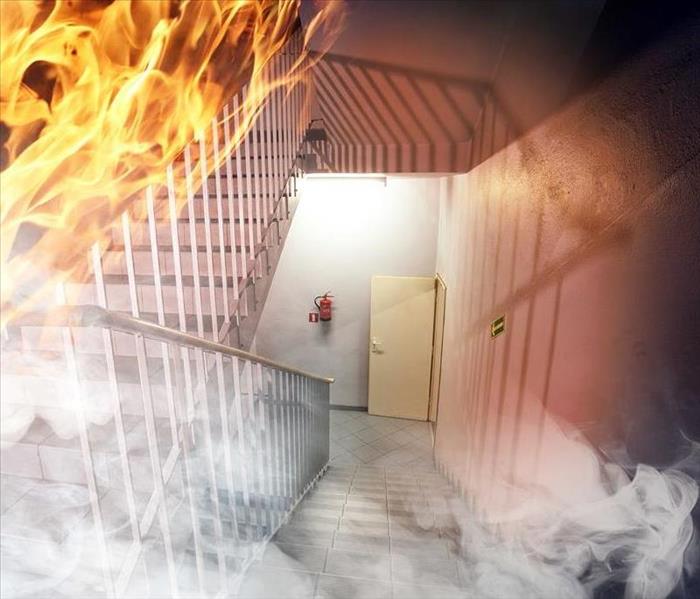 Our Professionals have Smoke Cleanup Methods that can Help you Avoid Further Damage.
Our Professionals have Smoke Cleanup Methods that can Help you Avoid Further Damage.
Anything that flames touch when your building in Pueblo, CO, catches fire can cause immense structural damage. That's not the only thing that happens, though. Smoke can infiltrate not only the area where the fire is actually located but also any space where the air around it can reach. It can even go so far as the building next door!
There are several ways that fire damage restoration experts can incorporate smoke cleaning during remediation.
Ways to proceed as regards Smoke Cleanup
Ozone Treatment
One method of getting rid of smoke and its telltale smell is through an ozone treatment. Technicians use a machine that creates ozone molecules much like the ones generated during a thunderstorm to naturally clean the air. They attach to smoke particles and destroy them. The treatment process is fairly straightforward:
- Seal off the space receiving treatment.
- Plug in the ozone machine and turn it on.
- Allow the machine to run for 3-6 hours.
- Let the room air out as the ozone settles.
It is not advisable to use ozone around people. The gas it creates is unstable, so the space will need to be vacated before the smoke damage treatment begins. However, in a relatively short amount of time, the odor will dissipate. Then the mitigation team can move back in to test and confirm that the treatment was successful.
Smoke Odor Filtration
Sometimes the only smoke cleaning a room needs is air purification. This is especially true in spaces adjacent to where the fire actually took place. Technicians use an industrial air filtration device with HEPA filters that process the air in the space and remove particles directly from it as it flows through the machine. Because it doesn't create any new molecules or chemicals, it is acceptable to use even in spaces that are populated.
Thermal Fogging
No matter how well technicians sanitize each surface, stubborn smoke odor can still linger. Smoke can travel anywhere the air goes, which means it gets into every crack and crevice that it can. This is particularly true while the fire rages and high temperatures make it easier for particles to permeate everything in their path.
A thermal fogger essentially recreates the conditions that are present during the fire. Instead of smoke, though, it spreads a deodorizer to all the areas where the damage reaches. No matter how small the cracks are in the space, the fog does a thorough job of soaking in. The cleansing chemicals neutralize the smoke and thus the smell that results from it. After the space is aired out, the odor is gone.
You can completely remove damaged structural elements and rebuild the ruined parts of your building after a fire, but if the mitigation team doesn't also take the time to get rid of the smoke issues, the odor is likely to linger. After assessing the problem, qualified technicians can choose the method that is best for getting rid of it. Smoke cleaning allows your building to smell as fresh as it looks at the end of the restoration process.
Why SERVPRO Is a Preferred Vendor
4/25/2022 (Permalink)
 Let SERVPRO be your Preferred Vendor, and Avoid Damage in your Property.
Let SERVPRO be your Preferred Vendor, and Avoid Damage in your Property.
As an insurance agent, you must balance the needs of your customer with the needs of your company. SERVPRO helps you do this by providing excellent service at an affordable price.
SERVPRO Vendor Program
We only use vendors that have met our rigorous standards. This is why we are the preferred vendor of many insurance companies.
Customer Satisfaction
Our top priority is making sure your customers are satisfied. We work hard to accomplish this in several ways:
- Limiting damage
- Restoring property quickly
- Restoring instead of replacing
We know that speed is important for avoiding additional damage and helping get customers back into their homes as quickly as possible. Our more than 1,900 locations in Pueblo, CO, and across the United States and Canada are prepared to respond quickly any time of the day or night. We also save you money by restoring property instead of replacing it.
Industry-Leading Training
All of our local professionals are trained on IICRC standards for fire and water cleanup and restoration. Our state-of-the-art IICRC-approved training facility provides continuing education for our service professionals.
Guaranteed Quality Work
We provide a two-year labor and one-year materials warranty on all our work. If our work fails to meet your reasonable expectations, we will fix it for free for up to two years.
Quick Response Time
As an insurance agent, we know that you have a lot of claims to handle. Our team will always respond promptly and will work with vendors so that you don't have to.
National Accounts Division
We have a team of marketing professionals dedicated to maintaining our relationships with insurance companies. The purpose of this division is to increase the satisfaction levels of both our insurance customers and the people they insure. We accomplish this by following guidelines that include internal audits for quality insurance.
We take steps to maintain transparent communication between our professionals and insurance agents and adjusters. We run a background check on all of our local employees, including temporary employees, and we provide completed job files as proof of work. Our account managers can guide you through the restoration process and answer any questions you have.
Performance Guidelines
To make sure you can be confident in our work, we have established performance guidelines. We provide thorough documentation of all claims. All of our locations must agree to 21 requirements to qualify to receive insurance referrals. We use the correct equipment and drying validation, per IICRC standards, on every job. We provide metrics to demonstrate high levels of customer satisfaction and performance.
History of Success
Our company began in 1967 as a painting contractor. We launched our first cleaning business in 1969. We achieved our first ranking in Entrepreneur Magazine's Franchise 500 in 1980 and we have been the #1 restoration service company on that list since 2003. We opened our National Training Center in 1992 and our 1,000th franchise in 2000.
SERVPRO is an industry leader for a reason. As an insurance agent, you can count on us to provide fast, high-quality service, while keeping costs as low as possible for you and your customer.
The Most Important Steps After a Partial Fire Loss
4/13/2022 (Permalink)
 Partial Fire Loss have many important Steps to Follow.
Partial Fire Loss have many important Steps to Follow.
The common image of a large business fire is one that burns down the entire structure, leaving only a few smoldering ashes and a vacant lot. Most fires, though, do not result in a total loss of property, but instead only impact part of the company. This fire loss could also involve such things as smoke and soot damage, as well as damage from fire suppression techniques.
When dealing with a partial loss fire, the company must deal with two important elements. The first is the cleanup from a qualified fire restoration service in Pueblo, CO. This business will work through the damage in an orderly fashion and seek to repair, replace and restore damaged items. In some cases, a restoration of an item will be more cost-effective, while other scenarios will call for a replacement of a damaged item.
The goal is always to restore the business as quickly and efficiently as possible. There is also a concern for the overall cost of the cleanup and restoration process.
A Partial Fire Loss and Insurance
The second critical element of a commercial fire involves working with the insurance company. This is often done in coordination with the cleanup service. In the best of worlds, the cleanup company will provide accurate documentation of such things as smoke damage to the insurance provider, and this will make the claims process run more smoothly.
Part of the process involves a thorough inspection of the damage. Depending upon the scope of the fire, this could mean looking at everything from structural and electrical damage to harm to furniture, lighting, computer equipment and documents. Companies should watch out for their own interests and make sure insurance adjusters do not miss any of the following damages:
- Hidden damage that is not automatically obvious
- Cleanup procedures that do not follow industry standards
- Repairs that do not match the quality of the original construction
The fire restoration and the insurance process should be orderly and professional, but each situation after a fire is different. If the fire is part of a larger disaster, it might be difficult for a company to find the necessary personnel to do the work. The company could also be demoted to a lower priority as emergency crews become busy with other projects, including the saving of life and limb.
Restoration and Insurance
At some point, the cleanup will focus on damaged items that can be restored to good shape again. This saves both the insurance company and the business time and money. A professional fire cleanup company has many tools at its disposal to restore items. This includes cleaning soot from walls, ceiling and flooring, as well as removing it from personal items.
The process also involves cleaning and sanitizing with a variety of techniques embraced by industry leaders. Industrial air scrubbers and fogging equipment can remove odors that cling to some items. In most cases, the insurance company should pay for these services.
A partial fire loss has many moving parts and can be a challenge for a company. Things tend to run more smoothly when the cleanup company and insurance work together after a fire.
We Have a 6-Step Process for Water Restoration
4/8/2022 (Permalink)
 Learn more about the Water Restoration Process by following these tips.
Learn more about the Water Restoration Process by following these tips.
Discovering that you have sustained water damage in your Pueblo, CO property is not enjoyable, but it is important to act quickly if it happens to you.
When you choose us for restoration, you can rest assured that you will receive an answer no matter when you call and that we will set our six-step process in motion. Here’s how we do it:
6 Steps to Water Damage Restoration
- Initial Emergency Contact
Water damage could strike any home at any time, which is why we are always at the ready. When you call us to report damage, we will always answer and gather all the details we can about your damage situation to craft a comprehensive response plan and get to you soon.
- Inspection and Damage Assessment
Inspecting the area for safety hazards and additional leaks is what we do first when we arrive on the scene. Once things are secured, we will do a full inspection to understand the scope of the damage and create your custom action plan for restoration.
- Moisture Extraction
Pulling out standing moisture from the impacted area is key to decreasing the overall restoration time, which is why we have ample amounts of equipment to do so. We will work tirelessly to vacuum and pump out all the water we can before moving onto more fine-tuned methods.
- Dehumidifying and Drying
Following the removal of standing moisture, we will then begin to extract water from the air and impacted surfaces. We will dehumidify and dry all impacted areas completely so they do not continue to deteriorate due to the water damage and to prevent them from becoming vessels for mold growth.
- Cleaning Belongings
The proper sanitizing and deodorizing of items that are affected is important to keep your home free of contaminants and odors in the future. We will fully treat the belongings that have been exposed to the water damage so you can be certain that they are safe to use.
- Restoration and Repair
You can count on us for a complete restoration process, which means we will even apply the finishing touches your job requires. We can apply paint or replace carpets to make the area feel exactly as it did before any water damage ever impacted it.
If your home has been water-damaged, you can count on us to help. Call us 24⁄7 to get the process started.
Choosing the Right Air Purifier To Remove Mold Spores
3/24/2022 (Permalink)
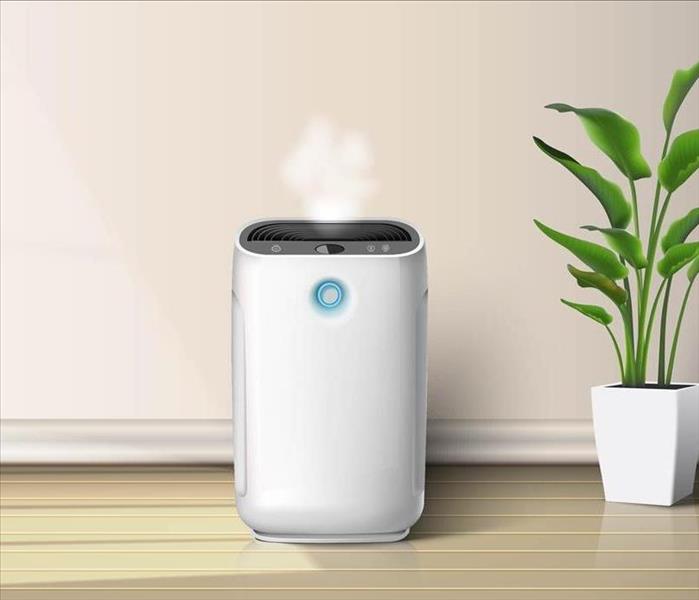 Choose the Right Air Purifier and Avoid Mold Damage by Following Our Tips.
Choose the Right Air Purifier and Avoid Mold Damage by Following Our Tips.
Ensuring your Pueblo, CO home is a safe, welcoming environment means thinking about indoor air quality. Unfortunately, mold spores easily enter the home via open doors and windows or by attaching themselves to clothing and other objects. If those spores get the moisture, warmth and nutrients they need, it may mean needing the services of a professional mold damage company. Installing an air filtration system is one way to minimize spores but not all are created equal.
Types of Purifiers for Mold
Each type of air purifier uses different technologies to clean the air. While some are designed to trap and collect particles, others are designed to simply absorb molecules. When it comes to mold, the former will not help prevent the spread of airborne spores. Below are the top three types made to prevent airborne particles from circulating:
HEPA:
These purifiers feature fine mesh filters that trap approximately 99.7% of pollutants sized .3 micrometers and above. Since fungi spores are typically around 3 to 30 micrometers, this type of device offers optimal peace of mind. A HEPA filter does require frequent replacement. If it is not replaced within six to 12 months, mold may start to collect on it.
Photoelectrochemical Oxidation:
PECO air filtration devices work by light activating a catalytic reaction. Instead of trapping contaminants, it destroys them by changing them into harmless compounds without producing byproducts, such as ozone, or reintroducing them into the air.
Ultraviolet Germicidal Irradiation:
UVGI uses UV lamps to eradicate bacteria, spores and viruses. While it has proven to do what it is designed to, time and area are key considerations. The light has to come into contact with the particles and usually takes several minutes or longer.
How To Choose the Right One
Every home is different, so it’s important to consider your unique situation before purchasing a purifier. Key considerations include:
This calculation is based on the clean air delivery rate. The higher the CADR, the faster and better it is at purifying a larger room. These measurements range in size for the type of pollutant.
This is measured using the Air Quality Index, which ranges from 0 to 500. Anything over 100 means the air quality is poor. It is important to choose a device that lists its AQI rating.
While this may not be a big deal for some people, there is noise associated with moving fans. The higher the setting, the louder it will be. For people who like quiet, a large purifier in a bedroom may not be the best option.
Other considerations come down to personal preferences and budgets. From smart technologies to alert systems, many come with the latest innovations. If budget is a concern, it’s best to research costs associated with filter replacement.
Keeping your home fresh and having peace of mind that pesky spores aren't floating around is important. An air filtration device is a good way to ensure invisible airborne particles are eliminated. To get the most out of your investment, ensure you purchase one that is designed for your needs.
4 Critical Kids Safety Lessons for Escaping a House Fire
3/16/2022 (Permalink)
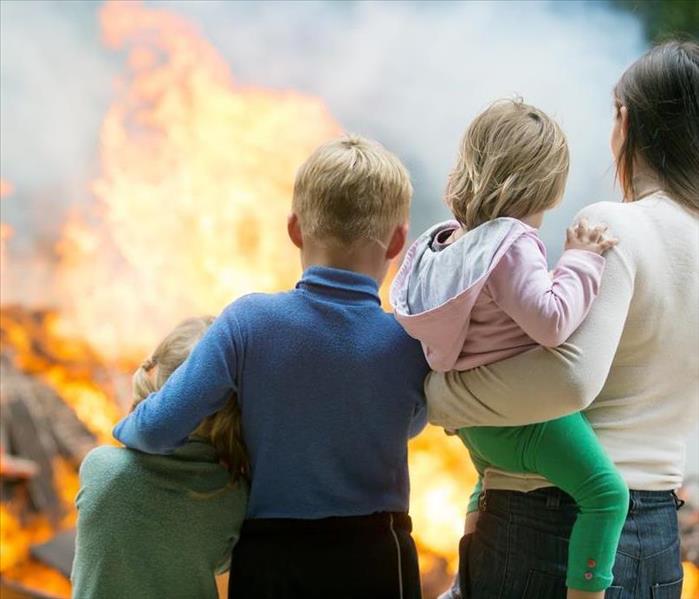 Learn more about How To Escape from a House Fire by following These Tips.
Learn more about How To Escape from a House Fire by following These Tips.
The National Fire Protection Agency notes that approximately 26% of blazes happen within a residential structure. These events are often sudden and quick, leaving little time to locate each other and discuss options. In addition, the situation proves trying for the youngest with Stanford Children's Health citing that almost 500 kids 14 and young die from the conflagration each year. Kids safety is essential and on the line.
How can homeowners safeguard their loved ones from harm?
Many adults likely remember cherished lessons of fire safety within schools. That information should also occur within the home. Parents can make a difference by taking a proactive approach to educating their little ones. The following are four critical survival tips to work on as a family.
1. Plan Out Kids Safety Efforts
Parents in Pueblo, CO, should sit down with their youth, creating a viable escape plan. Even little kiddos must know how to react since flare-ups could separate members. In addition, working through the big picture together allows adults to answer and clarify questions; plus, it minimizes the chance of confusion.
Discuss escape routes. Pick out several, drawing a map for your children to see. Walk through the paths, explaining that no one should go back inside or deviate from the designated walkway. Don't wait for others. Instead, plan a spot to meet up outside. Once there, adults can call authorities, insurance and a local fire remediation team.
Practice this plan frequently to ensure everyone remains on the same page.
2. Explain the Value of Smoke Detectors
When the alarm goes off at school, kids know the drill. Line up and leave. During a home fire, children should listen and react to smoke detectors. Show the device, and talk about how it works. The residence should have them throughout the property. When it notices smoke is in the building, the unit emits a loud sound, signaling a warning. Be sure that kids follow the family's escape guide if they hear the noise.
3. Review How To Handle Smoke and Heat
While some safety departures may occur with clear air and ease, others involve kids moving through smoke and increased temperatures. These changes require specific measures. Teach your children about how smoke moves to higher ground, so it's best to remain as low as possible. Show them specific positions such as crawls on the stomach or knees to protect them from excess smoke.
During a fire escape, little ones should avoid relying on their eyes. Instead, they need to feel around the room, checking door handles for excess heat. Consider playing a blindfold game, allowing your loved ones to move about the room, learning to find their way out without their eyesight. At times, alert them to hot doors and ask them to find another possible exit.
4. Open Windows, and Try Out Ladders
If a blaze blocks an exit, youth must adjust. Try out window escapes. Can you kids open it up? Do they know how to find the ladder or make a white signal flag for location? Pick days to run through these drills.
When a residential fire strikes, it's imperative that young ones know how to react. Adults can prepare them for these nerving times by putting kids safety first and setting aside time to talk about escape plans and have practice drills.
Engineering and Flood Prevention in Cities
3/12/2022 (Permalink)
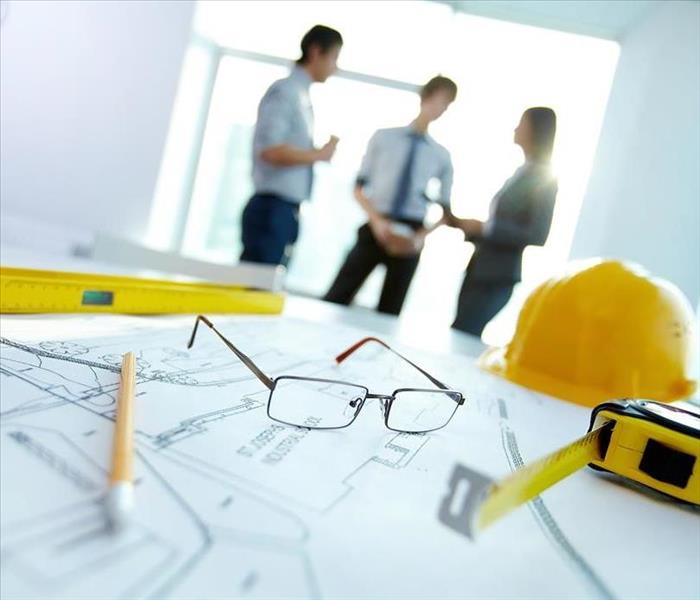 Engineering plays a key role in Flood Prevention. Learn more by following These Tips.
Engineering plays a key role in Flood Prevention. Learn more by following These Tips.
Have you ever wondered about the role of engineering in flood prevention in cities and municipalities? In places like Pueblo, CO that experience frequent high water and flooding, building structure and architecture play a huge role in preventing catastrophic damages.
In fact, many communities across the country develop plans to stop flooding and limit the damage and disruption flooding causes in an area.
Professionals who play a Key role in Flood Prevention.Agricultural engineers, civil engineers, environmental engineers, materials engineers, and mechanical engineers all play a vital role in flood prevention.
Agricultural Engineers
Agricultural engineers attempt to predict how water moves. These engineers utilize their predictions to determine the best location for retention ponds, wetland buffers, and greenways. Structures like retention ponds, wetland buffers, and greenways are permanent and created to hold water flow and control water. Agricultural engineers play a role in designing dams and structures that function similarly to dams.
Civil Engineers
Civil engineers provide city agencies and authorities with engineering analyses that help develop flood management plans. Civil engineers suggest infrastructural models for systems like drainage networks and flood gates.
These engineers conduct structures that contain and divert flood water. They develop structural designs that are utilized throughout cities and towns to prevent flooding.
Civil engineers also design transportation ways such as roads and train rails that can function in high water. They also design elevated bridges and buildings made to withstand flooding.
Ecological Engineers
Ecological engineers utilize the natural environment to prevent flooding. They combine ecology, or the relationship between humans and their natural environments, and engineering methods. When it comes to flooding, these engineers aim to prevent damage. They also implement models to design, construct, restore, and manage the environment.
For example, ecological engineers identify communities susceptible to riverine flooding. They may contribute to a city flood plan by combining green infrastructure practices with conserving land, possibly by identifying water-retention soils near the city.
Materials Engineers
Materials engineers study and develop materials at the atomic level and model the characteristics of the substances they research. To address flooding, materials engineers seek to lessen the severity of flooding and stop flooding. They design paving materials that are water-permeable and reduce water runoff, especially in cities.
Mechanical Engineers
Mechanical engineers work with electrical engineers to design generators and water pumps adaptable to high water. In areas that are at high risk for flooding, they may even put air conditioning units or heating units in elevated areas rather than at-risk places like basements.
In cities, mechanical engineers may develop technology designed to keep subways dry. In a subway system, mechanical engineers may use pumps that convert kinetic energy to hydrodynamic energy. This way, the pumps move flood fluids away from the subway.
Engineers and Flooding
Engineers provide other services that go into plans designed to stop flooding and flood damage. Chances are, engineers have played a vital role in protecting you and your city from flood damage. As a field, engineering considers flood engineering an area of expertise that requires certain skill sets and proper education. Some states even require flood control engineers to earn certifications and licensing before they can address floods.
Taking the First Steps Toward Flood Recovery | SERVPRO® of Pueblo
3/8/2022 (Permalink)
 If you’re experiencing any Water Damage from flooding, Follow these Tips and if you have more doubts, contact us.
If you’re experiencing any Water Damage from flooding, Follow these Tips and if you have more doubts, contact us.
Having your home damaged in a flood is a devastating experience, and a quick post-flood recovery is generally the top priority for those affected.
While it is understandable that this is important, it is also essential to be sure you are taking the right first steps and prioritizing your safety during the process. By making yourself aware of what steps to take, you can better prepare for and react to a flooding event in your area.
The First Steps for Flood Recovery
Avoid further safety hazards.
It is logical to want to immediately return home and get to work after a flood, but waiting for local officials to deem it safe is essential. Floodwaters can hide many lurking dangers, and returning to impacted areas prematurely can expose you to many hazards you may not be aware of.
Air out the home.
In addition to the damage from the flood specifically, impacted homeowners must also deal with the possibility of mold growth in their homes. Mold is an airborne fungus, and it thrives in areas that are moist with stale air. Circulating fresh air through your house is a good preventative for this—while it will not stop the growth entirely, it can significantly reduce it and make the air healthier to breathe as you begin the cleanup.
Document the damages.
Most homeowners want to start their cleanup process right away in a flood’s aftermath, but it is important to do your due diligence in the documentation before you begin removing items or cleaning up. Take ample photos of every room that has been impacted and make a detailed inventory list of all the items that have been damaged before you get started.
Contact your restoration and insurance companies right away.
If you have purchased flood insurance for your home, you will want to start the process of filing a claim right away to expedite it. Another thing to expedite is the restoration—leaving flood damage untreated can cause it to get worse, so call your restoration company right away after you discover the damage.
If your Pueblo, CO home has been damaged in a flood, we are here for you. You can contact us 24/7 to receive a quick response and set the restoration process in motion.
How To Get Ready for Storm Season
2/23/2022 (Permalink)
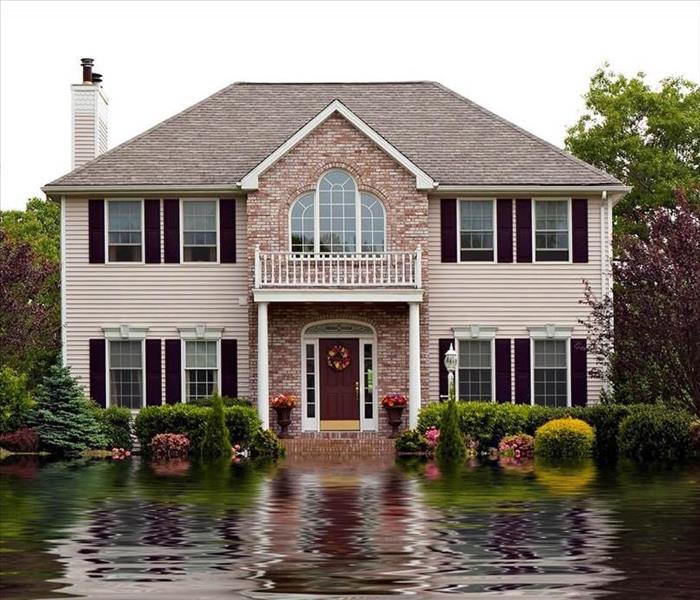 Get Ready for Storm Seasons by following These Tips. If you have more questions, just contact us.
Get Ready for Storm Seasons by following These Tips. If you have more questions, just contact us.
Every area has its own storm season. Some people experience heavy snow and ice while others have to watch out for damaging winds and hail. Flooding is often a factor during a storm no matter where you live, though. When storm season approaches in Pueblo, CO, there are a few things you can do to get ready.
Prepare Your Home
Your main goal in getting your home ready is to secure it so that you prevent as much flood damage as possible. A solid flood maintenance checklist will include inspection and repair of several areas of your property:
- Trim trees and shrubs to get rid of branches that can easily break off
- Install storm windows or shutters
- Seal all openings around doors and windows
- Check the roof for damage or weak spots
- Clean gutters and downspouts
- Inspect the foundation for fissures
- Insulate pipes
It is likely that many of these things are already on your regular maintenance to-do list, but they are especially important when you're expecting a flood. The stronger defense your home has against leaks, the lower the chance that you will have to have major repairs after the first major storm passes.
Stockpile Necessities
Whenever there is a strong weather event, services that typically function smoothly can be disrupted. Ice or heavy winds can break power lines, causing your home to lose electricity. Additionally, pipes may freeze if temperatures stay too low for too long. In addition to flooding concerns, you may also have to find alternative ways to keep your family warm and fed.
Start with water and food. You should have a three-day supply of drinking water for every family member as well as shelf-stable food that you can prepare without the use of your appliances. Keep your flashlights with extra batteries and a tool kit handy. If any family member needs regular prescriptions, make sure you keep them in a safe, dry place that you can access easily. Finally, make sure that your first aid kit is up to date and fully stocked.
Compile a List of Emergency Numbers and Inventory
It's always a good idea to have emergency numbers listed in a prominent location in your home, but it's vital during a storm. It's not hard to remember 911, but other people you may need to contact include storm damage mitigation experts, your family doctor or pediatrician and your insurance provider. That way, if there is damage or you need medical advice, you can reach them via landline if your cell phone dies.
You should always keep a running inventory of the items in your home and the cost it would take to replace them. It's smart to store an electronic copy in a secure location online so that even if the original list is destroyed in a storm, you still have access to it. This information is crucial for filing an insurance claim if covered items are damaged.
You can't control the weather, but you can do everything in your power to prepare for it. By checking things off your pre-season maintenance list, you may be able to save your home from the effects of major flooding.
How To Avoid Secondary Damage From Bursting Pipes
2/18/2022 (Permalink)
 Follow these tips To Avoid Secondary Damage From Bursting Pipes in your Pueblo, CO Property.
Follow these tips To Avoid Secondary Damage From Bursting Pipes in your Pueblo, CO Property.
Bursting pipes can cause serious damage to the plumbing in your building, but direct damage to the plumbing isn't the only problem they can cause. Secondary damage can cause extensive problems throughout your building.
Avoiding Secondary Damage From Bursting Pipes
Water damage from the broken pipes is one of the first things you may notice after a pipe breaks. There are several steps you must take to mitigate the damage:
- Shut off the water supply
- Fix broken pipe
- Inspect the plumbing for additional broken or frozen pipes
- Remove water and dry out the building and contents
You can shut off the water by either turning your main shutoff valve to the off position or contacting your utility company in Pueblo, CO. You may be able to repair the section of broken pipe yourself, but if not, contact a plumber to make the repair before you turn the water back on. Contact a water remediation company to remove any standing water and help dry out your building and contents. The longer wet conditions persist in your building, the more likely you are to have secondary damage from the water.
Secondary Damage From Water
Water from a burst pipe can cause multiple types of secondary damage. It may cause wooden materials to warp or rot. It can cause metal to rust. The high humidity may promote mold growth. In winter, moisture in the air freezes when it contacts windows and exterior walls and doors. This can cause damage to joints and drywall. The best way to avoid these problems is to fix the source of the excess water and dry out the property as quickly as possible.
Avoiding Burst Pipes
The most effective way to avoid secondary damage from burst pipes is to avoid the primary damage. There are several steps you can take to reduce your risk:
1. Leave the Heat On
Many business owners turn the heat down during closing hours to save energy. When cold weather is in the forecast, don't turn the heat down. Keeping your building warmer reduces the risk of a pipe freezing.
2. Increase Circulation
Pipes are often located in areas where warm air from your heating system may not reach. Open doors and cabinets to make it easier for warm air to reach your pipes.
3. Insulate Your Building
Insulation in the walls of your building and around your pipes can help prevent freezing. Pay particular attention to pipes that are outdoors or near exterior walls.
4. Let the Faucet Drip
Opening faucets enough to allow a drip keeps water moving in your pipes, which lowers the risk of freezing. If your building is going to be unoccupied during cold weather, you may want to shut off the water and drain the pipes.
5. Fix Holes
Check the walls of your building for cracks and holes and repair any that you find. This will help keep cold air out of your building.
Primary damage from bursting pipes can be a major headache for property owners. However, secondary damage can sometimes be an even bigger problem. Taking steps to mitigate this damage can save you a significant amount of time and money.
Advice Pueblo Business Owners Can Use to Rebuild After a Disaster
2/16/2022 (Permalink)
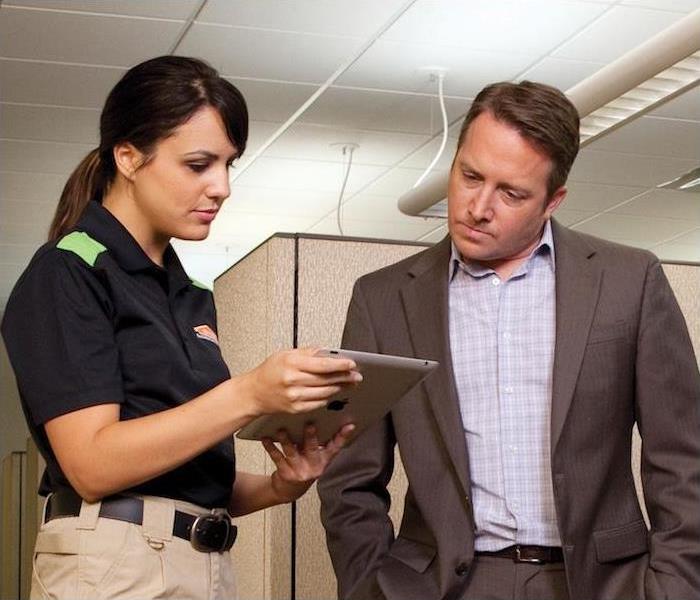 Keep your business running after a natural disaster following these steps.
Keep your business running after a natural disaster following these steps.
What was the most important lesson you’ve learned during the COVID-19 pandemic? A lot of business owners have a similar answer. It’s that you can’t plan for everything. Sometimes being smart and agile means looking for new ways to reach your customers and continue operating. And it’s impossible to predict what might happen in the future.
These are great lessons to learn, and they can move into other aspects of your business, including being prepared for more predictable natural disasters like severe storms, fires and floods. Many business owners already have disaster plans in place for these (even if they didn’t plan for a pandemic).
If you own a business in Pueblo, we’re here to support you during any time of disaster. We understand that planning for a disaster is one thing, but living through it and continuing to conduct business is something else entirely.
As a way to support you, we’ve pulled together some of the best tips we have to help you deal with moving forward after a storm, fire or flood.
Your Best Next Steps
You can reopen your business quickly and efficiently after a disaster. Here’s how we recommend that you do it:
Work your disaster plan. It’s smart to work on this plan before you need it because you’ll be in a better frame of mind to think things through. For example, some may consider moving to a backup location to continue offering services.
Work as closely as you can with your insurance company. Be ready to provide what your insurer will need to help you move forward. In most cases, that will be photos of the damage (before it’s cleaned up) or an inventory that details lost or damaged items if you can, including their value, too.
Keep your community in the loop. Don’t neglect your suppliers, your employees, your customers and your wider community. They’ll want to know how your business is progressing and any other ways they can support you. You can also share a temporary location using social media or an email list.
Choose reliable partners. Don’t work with any restoration company that doesn’t communicate regularly and uses advanced equipment designed to restore your business to its original state.
If a fire, flood or any other cause damages your business, you can always count on SERVPRO for restoration assistance. We have crews who are available 24⁄7 in the event of an emergency. Contact us at any time to learn more about our restoration services and how we can help you.
Protecting Your Home Against Flood Damage
2/16/2022 (Permalink)
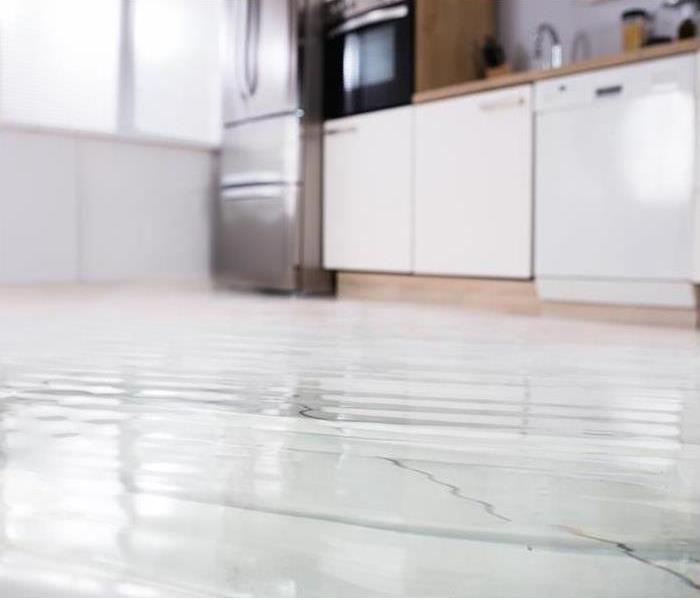 Floods can lead to severe damage in your Pueblo, CO home. Call us to avoid future risks.
Floods can lead to severe damage in your Pueblo, CO home. Call us to avoid future risks.
Worrying about flooding in your Pueblo, CO home may seem counterintuitive if you are not in an area prone to flooding, but with natural disasters involving flooding around 90% of the time, it would be unwise for homeowners to not prepare their homes in case of a flood.
Ways Homeowners Can Protect Against Flood Damage
While there is no way to practice prevention for floods, there are steps homeowners can take to limit the damage a flood may cause:
Know your risk. Use the FEMA Flood Map Tool or call the local branch of your emergency management office to better understand your risk and the precautions to take.
Discuss emergency procedures. Keep the entire family aware of the emergency and evacuation plan for the house. Teach every adult how to turn off the electricity main and make sure emergency supplies are easily accessible.
Elevate valuables. Important documents pertaining to the household, such as insurance papers, should be kept in a place that would be easily accessible and protected should you need to file a claim following the flood.
Prepare appliances. In the case of a shallow flood, appliances such as washers and dryers can be elevated on bricks or stands to protect the internal workings from water damage.
Turn off electricity. Even if you feel it’s unlikely that the waters would reach electrical appliances or outlets, prevent the risk of shock or electrocution by turning off the electricity supply to rooms that are at risk.
Raise hazardous materials. By elevating things such as oil, paint and cleaning supplies, you can prevent dangerous substances from spilling into the floodwater.
Anchor propane and fuel tanks. A tipped propane or fuel tank can pollute floodwaters or pose an explosion risk. Fuel tanks should be securely anchored.
Disasters such as floods are devastating, but a bit of pre-planning can go a long way in protecting your valuables and keeping your family safe.
If you’ve experienced water damage due to a flood or other causes, SERVPRO® of Pueblo is here to help. Our technicians are fully trained in water remediation, and our 24⁄7 Emergency Line means we’ll be there for you when you call.
How To Prevent Mold Damage After a Flood
1/20/2022 (Permalink)
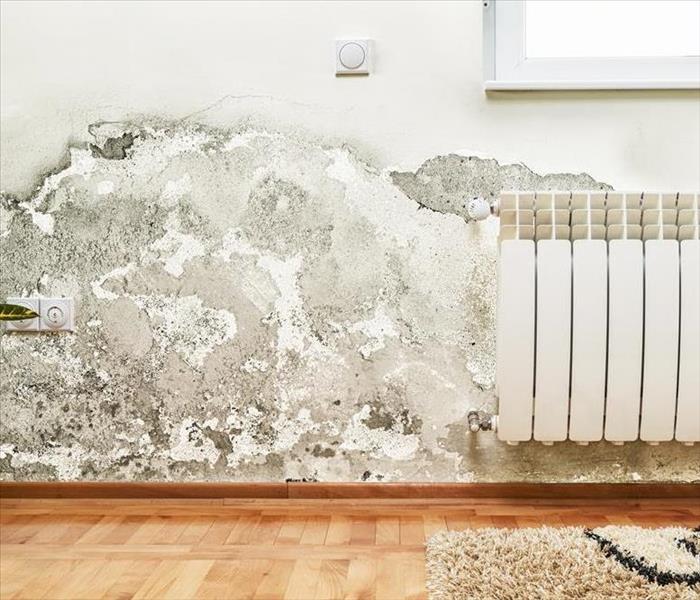 Prevent mold growth in your Pueblo, CO home by following these tips.
Prevent mold growth in your Pueblo, CO home by following these tips.
Flooding from a storm in Pueblo, CO, can cause a lot of water damage to your home. If you don't address the problem quickly, however, that may become only part of your concern. Mold growth is a common side effect in damp spaces, and once it starts to thrive, it can be difficult to get rid of. There are several things you must do to protect your home against a significant mold problem after a storm.
Important tips to prevent Mold Damage after a Flood
Quick Mitigation
The best thing you can do to prevent mold is to deprive it of the elements it needs to propagate. Mold can start to grow within as few as 24 hours after a flooding event because your home has become a fertile breeding ground for spores. They feed on not only the excess moisture itself but the bacteria in the floodwater.
A quick mitigation process is the key to stopping fungus from spreading. As soon as certified remediation experts arrive at your home, they begin the cleanup process:
- Assess the water and mold damage
- Remove excess water
- Tear out ruined materials
- Disinfect remaining structure
- Dry affected area
- Rebuild the affected area in your home
The sooner this takes place, the earlier you can get rid of any existing mold issues. You may even be able to prevent mold patches from starting to form at all!
Fast Repairs
Another piece of the prevention puzzle is getting to the root of the problem. Floodwaters that cause mold growth enter your home through points of egress. Start at the bottom of your home and work your way up. Look for cracks in the walls that indicate weak spots or a shift in the foundation and call professionals for repair. Seal the space around doors and windows so that rain can't get inside. If there are holes in your roof, have them patched quickly to prevent damage to the attic and upper levels of your home. Eliminate the sources of the moisture problem, and you can circumvent mold issues as well.
Humidity Control
Standing water doesn't just affect the surfaces it touches. After a flood, the air itself takes on extra moisture. High humidity levels can dampen surfaces and encourage mold spores to settle and multiply. There are a couple of things you can do to keep this from happening, though. Before mold has a chance to settle, increase the airflow in your home as you are getting rid of the excess water. This helps dry both the surfaces and the air. You can further reduce humidity by running a dehumidifier in the space.
Ongoing Inspections
After the mitigation team has completed the restoration of your home, watch for signs of recurring issues. A musty odor is an indication that you need to look for mold patches or call for an inspection. If mitigation is done properly, the mold is unlikely to return, but inspecting your home for new leaks or other problems helps you stay on top of it.
Mold growth is not a pleasant problem to deal with, but it can be eradicated from your home. Taking swift action and putting prevention measures into practice help keep the problem at bay.
6 Common Commercial Water Damage Problems
1/14/2022 (Permalink)
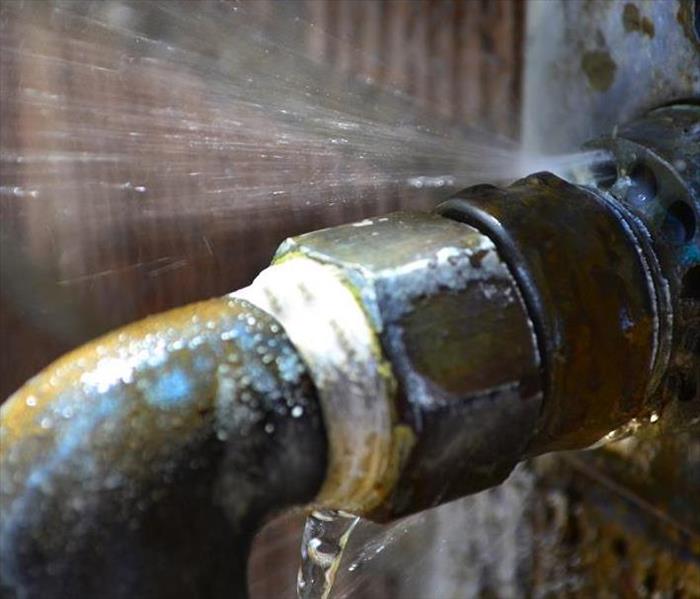 A broken pipe can lead to water damage in your Pueblo, CO commercial.
A broken pipe can lead to water damage in your Pueblo, CO commercial.
Water from a broken pipe or another source can disrupt operations and severely damage property. Quick action is critical to mitigating the amount of damage caused. Knowing the most common sources of commercial water damage can prepare you to act quickly if they occur on your property.
Common Reasons for Commercial Water Repair
Most commercial operations have some of the same water damage risks as residential structures, plus additional risks related to the operation of the business. These are some of the most common causes of flooding and other commercial water problems:
1. Leaking Sprinkler Systems
Sprinkler systems are a valuable resource for mitigating fire damage. However, damaged or poorly maintained sprinklers can lead to leaks that may damage your property. Watch for signs such as wet carpets and walls, mold, musty smells, and standing water. Have a professional in Pueblo, CO; inspect your sprinklers regularly and promptly repair any issues.
2. Damaged Windows
Damage to your windows or window seals can cause moisture to seep into your building. This excess moisture can cause mold growth, warp wood and lead to other types of water damage. Regularly inspect your windows and window seals for damage. Caulk damaged seals and repair or replace damaged windows as needed.
3. Plumbing Issues
A broken pipe can cause a substantial amount of damage if you are not quick about shutting off the water source. Freezing temperatures, wear and tear, and lack of maintenance can lead to pipe failures. Water stains on floors, walls, or ceilings, musty smells, and loose or cracked tiles can be signs of a leaky pipe. If you suspect a plumbing issue, contact a plumber to perform an inspection and repair any damage. Removing the water from your building is critical for reducing the damage, so consider contacting a water remediation company to dry out your property quickly.
4. Roof Damage
The roof on your building helps protect your property from wind, rain, and snow. However, a roof that has been damaged by a storm, heavy snow, ice accumulation, tree limbs, wind, or wear and tear may develop leaks. A leaking roof can lead to damage to ceilings and other structures in your building. Regular roof inspections, maintenance, and repairs can help you avoid damage from a leaking roof.
5. Damaged HVAC Systems
As your HVAC system ages, the ducts can become damaged or worn, leading to water leaks. Regular cleaning and maintenance reduce the chance of this occurring.
6. Severe Weather
The risk of weather damage to your property varies depending on where your property is located; however, most geographic regions experience severe weather at least occasionally. Hurricanes, flash floods, thunderstorms, heavy snow, earthquakes, and other events can either directly cause water damage or can create conditions, such as holes in your roof, that lead to water damage. You can't prevent bad weather from happening, but you can take steps to weatherproof your property.
Whether are you dealing with damage caused by a broken pipe, a flood, or poor maintenance, the key to reducing water damage is to act quickly. Regularly checking for signs of these common causes of commercial water damage can help you spot and fix problems early.
What to Look for in a Restoration Company
1/11/2022 (Permalink)
 A quick response from SERVPRO of Pueblo ensures your damage restoration needs are professionally completed.
A quick response from SERVPRO of Pueblo ensures your damage restoration needs are professionally completed.
It is important for Pueblo, CO homeowners to be prepared for damages, both by understanding their risks and having a plan for what to do in the aftermath. Picking a restoration company is an important and often overlooked part of this process. It is important to do your research and pick a company that you can trust to restore your home.
Tips To Choose the Best Restoration Company
Finding a restoration company to work with can be difficult, but knowing you made the right decision will provide you with ample peace of mind once the time for restoration comes. In order to make the best decision, it is important to know the details that matter about your restoration company:
The Damages They Can Handle
Because there are many facets to every type of damage, it is important to choose a company with a wide scope of service. By being certified in many types of restoration, we have the competence and the expertise to handle it all. Whether your fire damage also requires air purification or water damage leads to structural issues, we’ll be able to help with every step.
When They’ll be There for You
House damages do not stick to a schedule, so finding a company that will be there for you whenever you need them is very important. That’s why we have an emergency line that’s available 24 hours a day; regardless of when you need to call in, our team will be here for you.
The Quality of Work You Can Expect
In the restoration industry, how technicians are trained has everything to do with the quality of work they complete. Training is an important focus for us, which is why we use the best industry standards to create our qualifications.
What Their Disaster Plan Is
Because we are a franchise that is part of a national chain, we are a local business with national resources. We have 1,700 franchise locations spread across the country, which means that when a large-scale disaster strikes, we have the backup necessary to maintain excellent levels of service.
If you have experienced storm damage, we are always here to help! Call our restoration experts 24⁄7 so we can address your damages quickly.
Kids Safety: Fire Escape Plans
1/6/2022 (Permalink)
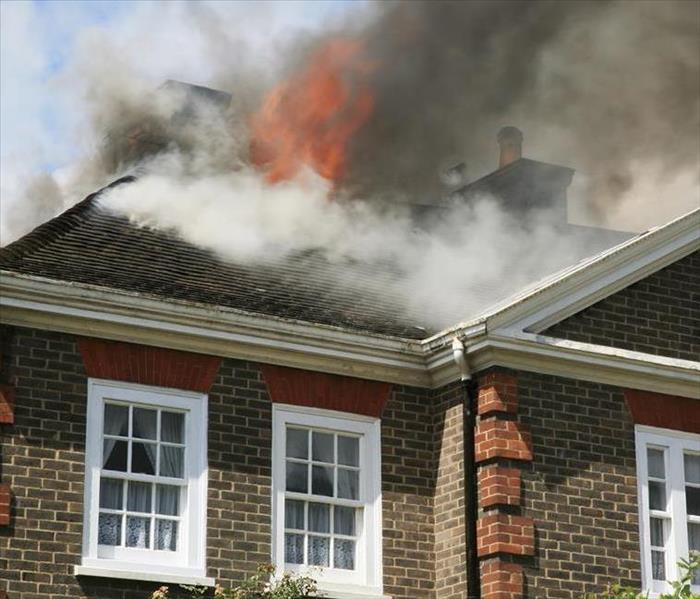 Follow these advices to create a good Fire Escape Plan for your family. Someday these tips could save lives.
Follow these advices to create a good Fire Escape Plan for your family. Someday these tips could save lives.
What does every parenting book on the planet stress the importance of? Kids safety. However, aside from maintaining doctor appointments and learning practical first aid, how many parents reach beyond to learn and interject more safety protocols into their children's lives?
Many parents instinctively act in their child's best interest, which is excellent. However, what does that teach the child, especially in terms of emergencies like fires?
Advices that might be vital in case of Fire Escape
Many families do not see house fires as realistic threats, but they are; just ask any restoration service in Pueblo, CO. Teaching children escape strategies through repetition and exercises is the best way to keep the family safe. Learning to protect themselves can also serve as a psychological boost as it:
- Improves confidence
- Incorporates decision-making skills
- Reduces anxiety
Kids Safety: Fire Escape Training
While intuition can play a role in safety, it should not become the sole influence. The body's fight or flight response is not always dependable and can lead to greater risks of injury in disaster situations. Instead, parents should help their children create, incorporate, and practice real-world strategies for escape during fires. These plans should include several exit routes and the elimination of obstacles.
Additionally, a plan is only as effective as its practice runs. During a disaster or crisis, people panic. Unfortunately, panic can lead to indecision. Repetition can reduce the risk of a panic-induced freeze, helping your entire family get to safety.
Specific Objectives
A home fire is dangerous, but knowing how to design and implement an escape plan can reduce the risk of serious injury. A plan should focus on multiple exits and the elimination of obstacles.
Every room in your home should have a minimum of two exits. A bedroom, for instance, will have a window and a door. When creating your family escape plan, your job is to identify these exits and teach your children.
Additionally, your escape path out of each room or area of the home needs to be clear. Smoke is thick and hard to see through; you do not want to run into a bookshelf, table, or another item while trying to make a quick escape.
Importance of Repetition
Because of the potential for low visibility and the threat of panic-induced freezing, you should practice your escape routes several times throughout the year. A good rule of thumb is to practice at least once every six months. However, you might want to practice monthly with little ones.
By practicing, you are essentially creating muscle memory and eliminating the need for too much thinking during a fire. It is the confusion and overthinking that will lead to extensive injuries.
Kids safety depends on preparation and commitment, and each is up to the parents. The younger you start teaching your children about escape plans and fire safety, the easier it will be to instill good habits. You can talk to the local fire department or a fire mitigation specialist to determine the best escape routes through your home and learn other fire safety tips and tricks. However, it would be best to remember to practice what you learned.
Does Your Business Need a Disaster Plan?
12/20/2021 (Permalink)
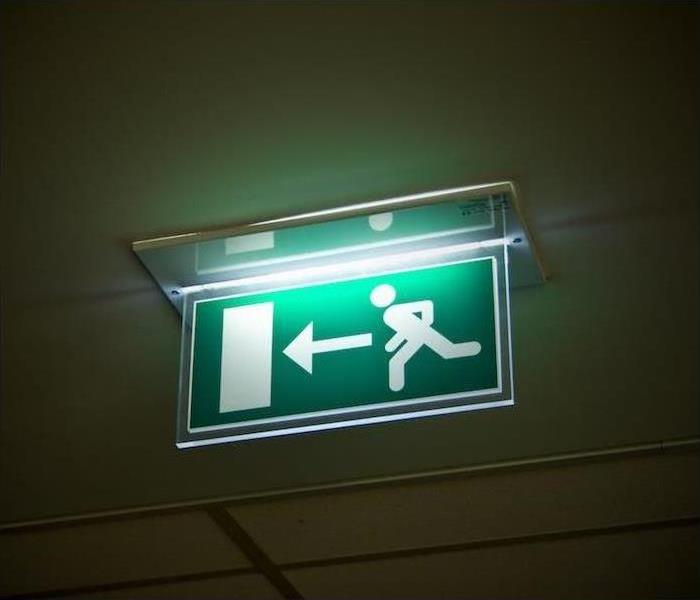 Keep everyone safe when a disaster occurs in Pueblo, Co.
Keep everyone safe when a disaster occurs in Pueblo, Co.
Have you noticed how Mother Nature keeps throwing natural disasters such as floods, hurricanes, tornadoes, wildfires, and earthquakes at our Pueblo, CO commercial? The key to being able to fight back is being prepared for a multitude of worst-case scenarios.
Being prepared for those scenarios in your home as well as your business involves creating a natural disaster plan. In this blog, we are going to discuss some aspects to consider when designing a disaster plan for your business.
Why Disaster Planning?
There are many things to factor in when you are putting together a disaster plan for your business.
Included in those considerations are the following:
- Keeping your employees protected
- Keeping your assets secure
- Getting your business back up and running again
Many sources such as the Red Cross, FEMA, and Ready.gov have prepared helpful checklists that can guide you in identifying areas that need to be included in your natural disaster preparedness plan. These sources are also useful in measuring just how prepared you truly are.
How to Protect Employees
Protecting the human aspect is the most important consideration if a disaster were to strike without warning. You must have a plan that lays out procedures and safety measures for employees and visitors by making sure evacuation routes and exits from your facility are all properly marked, ensuring that there is a designated area that can serve as a shelter space, possibly considering the installation of emergency lighting, and creating a volunteer staff to serve as “safety wardens” who are properly trained and able to guide and assist with all emergency efforts.
When you are picking out a shelter space, a basement or storm cellar is an ideal location in the event of tornadoes or other high-wind situations. If you have no basement space, you may use a small interior room, a closet, or an interior hallway on the lowest level of the building for shelter.
Asset Safety Is Key
There are thousands of dollars at risk in assets and merchandise even if your business is located in a strong and sturdy brick and mortar location. You will have to make mindful choices about how to protect the assets on the inside.
It is a good idea to compile a comprehensive and up-to-date inventory of these items, and having photographs prior to a disaster whenever possible is always helpful when filing insurance claims. When you have assets that are based on a computer server, take necessary steps to ensure that the regular backups are being performed and look into storage systems such as cloud storage options that cannot be damaged.
Contact a contractor to help you uncover areas that may need structural integrity upgrades if you own your building, and have the contractor walk you through possible safety upgrades and advise on any areas that may not hold up in certain weather situations.
How to Get Back to Work
After a natural disaster occurs, it is quite possible that damages will force you to close your business down while repairs are being made. Every day you remain closed is another day you lose money and profits. It is a good idea to have a “rainy day” fund set aside to help out with any additional costs that are not covered by your insurance.
Knowing what to do when disaster strikes your business is of the utmost importance. When it comes to the cleanup and restoration aspects, call SERVPRO of Pueblo and we will there for you.
Avoiding Holiday Hazards
12/20/2021 (Permalink)
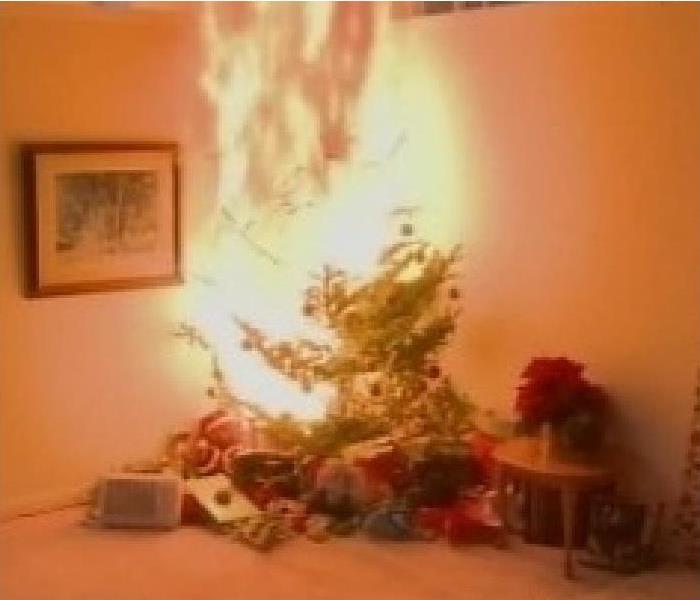 Consider these preventions tips in the holidays to avoid any type of fire damage.
Consider these preventions tips in the holidays to avoid any type of fire damage.
Pretty lights and decorations add to the feel of the holiday season, but if they are not used properly your holidays can quickly go from festive to frightening. Fortunately, by following a few simple safety tips, you can greatly reduce the fire risk in your Pueblo, CO home, this holiday season.
Tips To Avoid a Fire in Holidays
Candle Safety
Candles are widely used throughout the holidays, and December is the peak month for home candle fires. The National Fire Protection Association's (NFPA) statistics show, more than half of all candle fires start because the candles were too close to flammable objects. Consider using flameless candles instead of real candles, keep them at least 12 inches from anything flammable, and remember to extinguish them when leaving a room or going to bed. Use sturdy candle holders that are not likely to tip over and place candles on clear, uncluttered surfaces.
Christmas Tree Safety
The NFPA also reports local fire departments to respond to an average of 250 Christmas tree-related fires each year, with the majority of these fires caused by electrical problems.
If you have an artificial tree, be sure it is labeled, certified, or identified by the manufacturer as a fire retardant. If you choose a live tree, pick a tree with fresh, green needles that do not fall off when touched, and make sure the tree has plenty of water every day.
Make sure the tree is at least three feet away from any heat source, like fireplaces, radiators, candles, heat vents, or lights. The tree should also be clear of all exits. After the holidays, properly dispose of your tree. Dried-out trees can be a fire hazard and should not be left in the home or garage, or placed outside the home.
Decorative Lights
When purchasing decorative lights, make sure they are properly labeled and have been inspected by an independent testing laboratory. It is also important to ensure you have the correct type of lights; some lights are designed for only indoor or outdoor use, but not both. Carefully inspect light strands before placing them. Replace any string of lights with worn or broken cords or loose bulb connections.
Connect no more than the number of light strings recommended by the manufacturer. Remember to turn off outside decorative lights and Christmas tree lights before leaving or going to bed.
Your local SERVPRO OF PUEBLO wishes you a safe and happy holiday season!
Ways to Protect Your Home From Water Damage
12/20/2021 (Permalink)
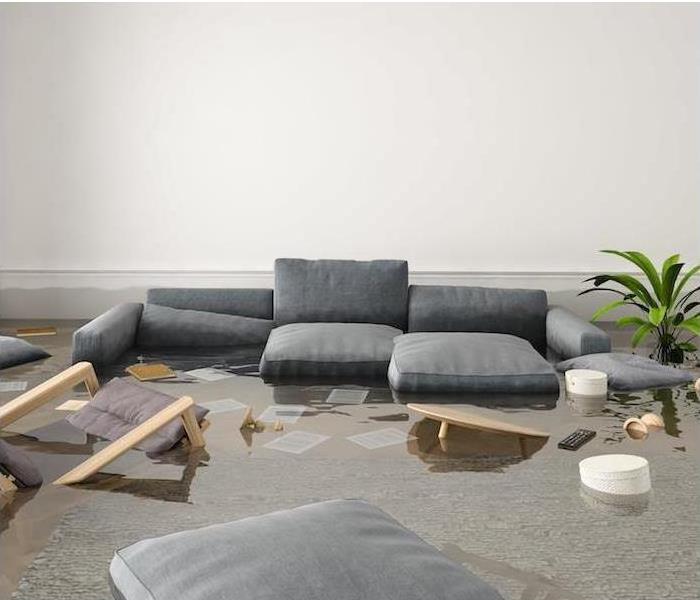 Water damage can be a disaster. Call us to help you recover your Pueblo, CO home.
Water damage can be a disaster. Call us to help you recover your Pueblo, CO home.
Water damage is one of the most common and costliest disasters you may experience as a homeowner. Pipes bursting, dishwashers malfunctioning, washing machines overflowing or storm damage are just a few of the many ways water damage could strike your home.
There are plenty of ways you can protect your Pueblo, CO home from this common issue homeowners deal with. Let’s take a look at some.
How to Protect Your Home
Not only will water damage be a hassle to deal with, but it could quite possibly have a long-term impact on your home if cleanup is not done properly. Mold will begin to grow within 24–48 hours after moisture exposure and is one of the most common side effects of water damage.
When you begin to look for ways to protect your home, it may help you to break it down by areas of impact. These areas might include the basement, kitchen, bathroom, flooring, and ceilings.
Basement
You can help prevent water damage in the basement by preventing water seepage. This can be done by resealing vulnerable areas of the basement, making sure water drains away from your home, and installing a backwater valve.
Kitchen and Bathrooms
Your kitchen and bathrooms can experience water damage due to plumbing issues and appliance failures. Take some time and follow these recommendations:
- Inspect all appliances regularly, especially paying attention to hoses and faucets
- Check all seals and caulking around showers and tubs to ensure there is no leakage
- Know where your home’s main shut-off valve is located
- Be sure that you don’t leave the house while the washing machine or dishwasher are running
How to Recover Your Items
There are things you can do to protect the possessions in your home from water damage, but don’t be surprised if it is not always possible. Use waterproof bins to store items and keep items stored on shelves off of the floor—which is especially recommended when using your basement for storage.
You’ll need to contact your insurance company immediately, evaluate the extent of the water damage in your home, and identify the type of water that is involved.
Types of water to be aware of are:
- Clean water. Can be from rain, condensation, leaky pipes, etc.
- Gray water. Slightly dirty water from dishwashers, washing machines, clean toilets, etc.
- Black water. This water can cause serious health problems and is water from sewage or serious flooding from nearby rivers, etc.
You will need to remove all wet objects, dehumidify and dry your home out quickly after a water damage disaster, and disinfect any remaining materials.
The pros suggest that you freeze wet books, photos, and papers in a frost-free freezer to buy some extra time and prevent mold and mildew from developing and causing further deterioration. Once able, you can remove them from the freezer and air-dry or fan-dry the pages.
It may seem like recovering from water damage is an overwhelming and slightly impossible task, but it doesn’t have to be. You can call on the highly trained experts at SERVPRO of Pueblo, who are here to make it "Like it never even happened."
What Homeowners Can Expect From SERVPRO
11/30/2021 (Permalink)
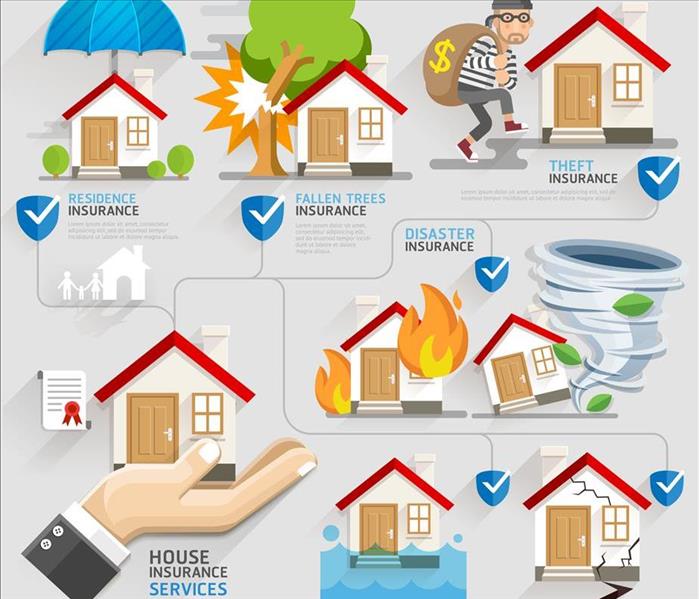 Call SERVPRO to help you with the restoration and cleaning of your Pueblo, CO home.
Call SERVPRO to help you with the restoration and cleaning of your Pueblo, CO home.
As an insurance representative, you are probably well aware of SERVPRO's reputation when it comes to commercial cleaning. The company exceeds industry standards in mitigation and restoration services. What you may not know is how well SERVPRO can meet the needs of your residential clients in Pueblo, CO.
SERVPRO Restoration Services
Structural Repair
After disaster strikes your client's home, SERVPRO technicians go to work. They handle mitigation of multiple types of damage:
The cleanup process starts with an assessment of the damage, and technicians often work with adjusters to detail what needs to be done. Then they tear out ruined materials, clean and dry the area and rebuild the structure of the house. The job isn't finished until it looks "Like it never even happened."
Document and Personal Item Restoration
SERVPRO technicians don't just stop at repairing your residential clients' homes. They offer a certified clean guarantee for restorable documents and personal items. Family photos and keepsakes, clothing, window treatments, electronics, and furniture are just a few of the items they may be able to salvage. This saves both the client and your company the trouble and cost of replacing many of the belongings affected by the disaster.
Claims Information Center
The Claims Information Center is SERVPRO's data hub. It stores up-to-date information on every job in progress so that your clients have all the information they need to file their insurance claims. The CIC provides homeowners with the same level of service as commercial cleaning clients receive so that they can stay informed about the process every step of the way. The initial assessment and estimate are included, and if any changes need to be added along the way, your client's file in the CIC is updated to reflect them. The result is that at any given moment, you and your clients can track the progress of the restoration to their homes.
One-Stop-Shop
One of the reasons SERVPRO is a preferred vendor for many insurance providers is that it acts as a one-stop-shop for repair and restoration. The team that handles mitigation of the damage to your client's home is the same group that puts the finishing touches on the restoration. The technicians report updates back to the same company, improving communication and streamlining the entire process.
The results of this excellent service feature are typically a shorter timeline for completion and a lack of overlap from two companies claiming to have performed the same service. Homeowners don't get caught in the middle, trying to figure out a whose claim to the insurance money is more valid. It also keeps providers from being inadvertently overcharged for services that can fall into either phase, such as carpet cleaning. Hiring the same company to complete both mitigation and restoration makes the whole process easier for everyone.
SERVPRO offers the same quality of service to residential clients as it does for commercial cleaning assignments. When disaster strikes your clients' homes, it makes good sense to call SERVPRO. With 24-hour service, these certified technicians are Faster to Any Size Disaster, even residential ones.
Navigating Commercial Insurance, Mold Exclusions, and Professional Cleanup
11/17/2021 (Permalink)
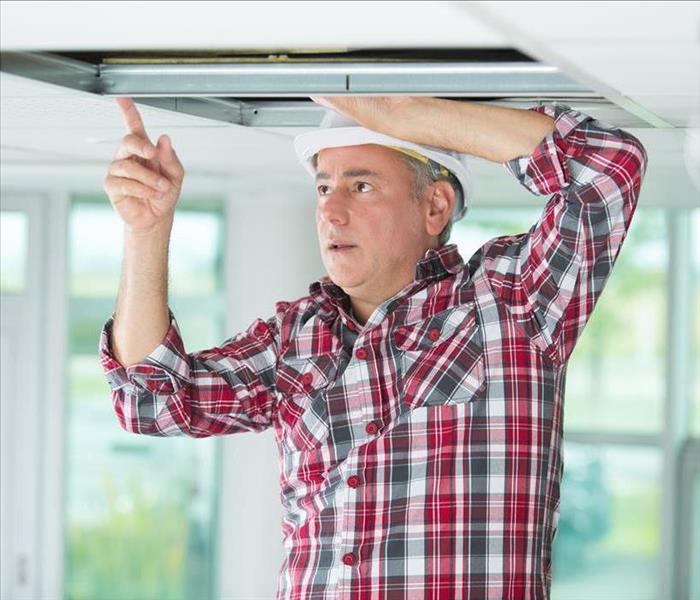 Mold grows in almost any environment. Take some steps to prevent the spread of the fungus in your Pueblo, CO, property.
Mold grows in almost any environment. Take some steps to prevent the spread of the fungus in your Pueblo, CO, property.
It doesn't take much moisture to create a welcoming environment for mold spores. If your Pueblo, CO, property is affected by heavy rainfall, melting snow, hurricanes, leaking pipes, or any other type of water disaster, you could end up dealing with mold damage. When mold remains hidden and you don't recognize the problem, the damage can become extensive. If you have a good commercial insurance policy, the mold issue may be covered. It's wise to be aware of mold exclusions, however.
Understand Commercial Insurance for Mold Damage
Mold exists in almost every type of environment, and spores move easily from one host to another. With just a tiny bit of warmth, moisture, oxygen, and food, a spore can establish a colony on wood, carpet, paper, and drywall. As mold feeds, it weakens its food source, eventually destroying property. Mold insurance covers some of the cleanup and remediation expenses.
Limited Fungus Coverage
According to policies from the International Organization for Standardization, Limited Fungus Coverage kicks in when fungus, wet or dry rot, or bacteria is caused by a specific cause and is addressed quickly and appropriately by property owners. Any fungus growth related to flooding may not be covered without flood coverage through an endorsement. If you take action at the first sign of mold, Limited Fungus Coverage usually covers:
- Direct loss or damage
- Removal of fungus
- Tear out and replacement of property
- Removal of damaged property
- Repairs
Your insurance company may limit the amount that is paid out for these services, so it's best to prevent mold growth or catch it early.
Mold Exclusion
Professional mold cleanup services are covered in most situations, but some insurance policies contain mold exclusions. This generally means that there is no coverage for the presence of mold, any spread, or related concerns. The most common reason for exclusion is a failure to properly maintain the property. However, the exclusion cannot apply to:
- Mold or fungus that results from lightning or fire
- Mold growth resulting from specified causes, such as riots, vandalism, sinkhole collapses, windstorms, and damage from firefighting equipment
- Specific losses caused by the presence of fungus or mold
Make sure you understand your coverage before trouble happens.
Maintenance and Prevention
The best mold insurance happens before you need to file a commercial insurance claim. You can take preventative steps to avoid fungus:
- Routinely inspect your building, especially targeting common problem spots, such as vents and drainage systems.
- Use dehumidifiers and fans to reduce the level of humidity in your building.
- Hire professionals to inspect and maintain the ventilation system, including vents, ducts, and working components.
- Take immediate action at the first visible sign of mold or the first whiff of a suspicious odor.
Remember your insurance provider is probably as concerned about preventing the spread of mold as you are. Reach out to your agent or an insurance representative to learn more about the risk of growth and the most effective means of prevention.
Mold can be a real headache for property owners. However, with the proper preventative actions and a good understanding of your commercial insurance, you can reduce the amount of property damage and minimize your own level of frustration.
Count on Us to Respond to Your Disaster Fast
11/12/2021 (Permalink)
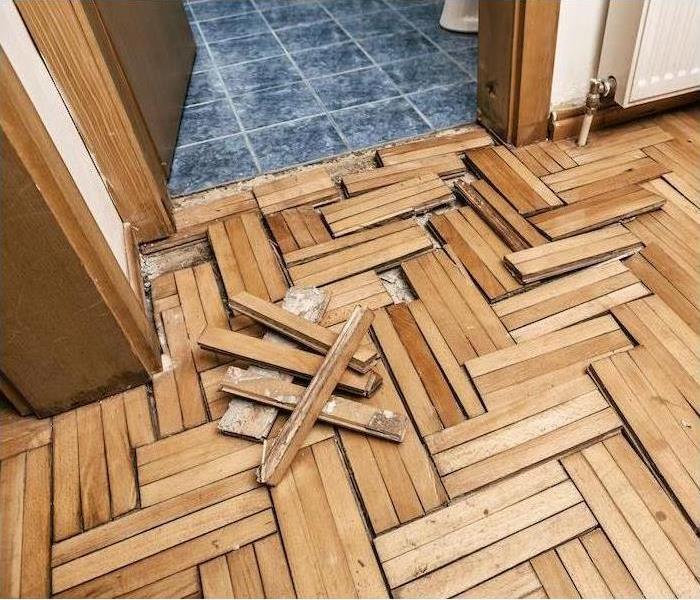 Our professional team can restore the damage in your Pueblo, CO home.
Our professional team can restore the damage in your Pueblo, CO home.
When disaster strikes your home or business, you don’t have the benefit of waiting for help when it is your home or livelihood on the line—you need it right away.
We Are Here to Help You
We understand that a fast response is crucial, which is why responding faster to any size disaster is more than just a slogan to us.
Why Responding Quickly Matters
Time becomes a precious commodity when it’s your belongings or business on the line. This is especially true where the water damage has been involved, which can happen through various means such as flooding, appliance and/or plumbing failures, storm damage, and firefighting efforts.
It only takes a matter of mere minutes for the water to spread throughout your property, saturating the walls, floors, upholstery, and your belongings, which all become casualties of water damage.
The effects of water damage within the first 24 hours include:
- Drywall beginning to swell and break down
- Metal surfaces beginning to tarnish
- Furniture beginning to swell and crack
- Dyes and inks from cloth and paper items spreading and staining
- The beginning of a musty odor
The damage will continue to worsen as time goes on. Anywhere from 48 hours up to a week later, you could begin to see:
- The growth and spreading of mold and mildew
- Swelling and warping of doors, windows, and studs
- Metal begins to rust and corrode
- Paint beginning to blister
- Wood flooring swelling and warping
- The possibilities of serious biohazard contamination
If left untreated for more than a week, water can lead to dramatically increased restoration times and costs and can also have an impact on structural safety.
How We Can Help
We can provide an immediate response to any size disaster, which can help keep damage to a minimum and help keep the cleaning and restoration costs manageable.
We have trained cleanup and restoration specialists that can be dispatched to your property or business at any time, no matter what day or time it is.
A major perk of being part of a national network of over 1,700 franchises is that we have access to more resources for the cleanup and restoration projects that may be larger or stem from major storm situations. Also, since we are a locally owned and operated franchise, we are close by and ready to respond whenever the call comes in.
Remember, if you need us, we’ll be there—no matter the time of day. The team of highly trained restoration experts at SERVPRO of Pueblo, CO, is available for emergency cleanup and restoration services 24 hours a day, seven days a week.
Ways You Can Protect Your Business From Fire
11/10/2021 (Permalink)
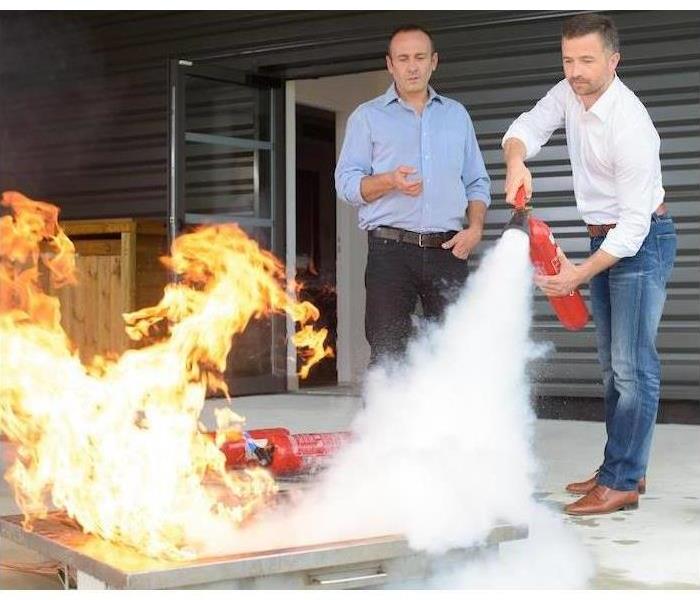 Take some prevention steps to avoid further damage in your Pueblo, CO business.
Take some prevention steps to avoid further damage in your Pueblo, CO business.
When you own a business, you must take safety precautions for your business, employees, and visitors. One of the things you need to consider and spend a little extra time planning for and working toward is fire prevention.
The National Fire Protection Association (NFPA) reports that the leading causes of structure fires in office properties from 2007–2011 were (in order):
- Cooking equipment
- Electrical distribution and lighting equipment
- Heating equipment
- Intentional
- Smoking materials
- Exposure
- Electronic, office, or entertainment equipment
Of those causes, intentional, exposure, and electrical distribution, and lighting equipment accounted for the most property damage with 20%, 18%, and 15% respectively.
In 2007, the Bureau of Labor Statistics found that fires and explosions accounted for 3% of all workplace fatalities.
In studying more recent numbers, the NFPA estimates that during the period from 2007–2011, U.S. fire departments responded to an average of 3,340 fires involving office properties per year. Those were responsible for an annual average of four deaths, 44 injuries, and $112 million in direct property damage.
You Can Protect Your Business
So what are some of the many steps you can take to protect your business? By focusing on fire risk assessment, fire prevention, and staff education, you will be working to reduce the chance of a fire breaking out.
Make an Assessment of Any Fire Hazard Risks in Your Facility.
In some locations, your local government may have a fire marshal who can visit your establishment to help identify these risks and provide guidance.
Right Fire Protection Equipment.
This includes an automatic sprinkler system, smoke detectors, and fire extinguishers on each floor.
Fire Plan
Most importantly, consider your employees and visitors. Creating a plan and reviewing it with your staff will ensure everyone knows what to do in the event of a fire. Conduct fire drills at least once a year to keep that safety protocol fresh in their minds, and take time to review evacuation plans and the location of first-aid kits.
Despite best efforts and safety tips, the worst could always happen at your business in Pueblo, CO. If a fire has damaged your business, SERVPRO is available to help make it "Like it never even happened."
What Category of Water Damage Is a Broken Pipe?
10/22/2021 (Permalink)
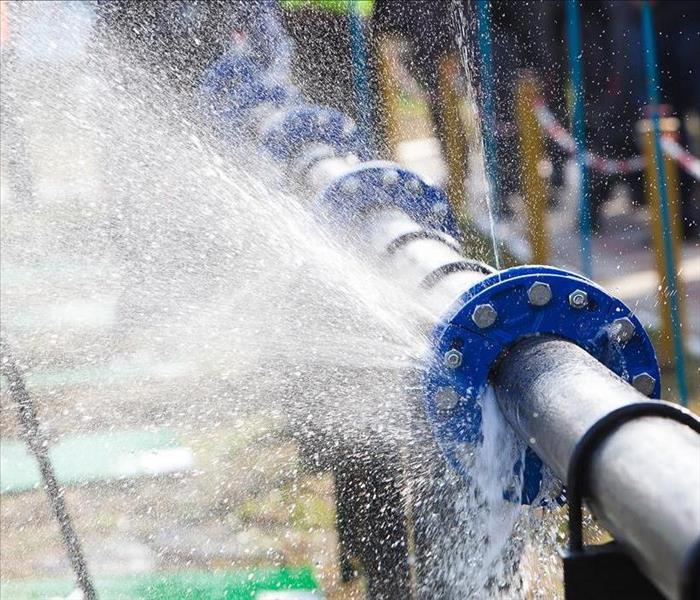 The cleanup of your flooded building in Pueblo, CO, will depend on the category of water.
The cleanup of your flooded building in Pueblo, CO, will depend on the category of water.
Water damage can be tricky to deal with regardless of the source of the water. However, some types of water damage are more difficult to contend with than others. If you have water damage due to a pipe that needs water pipe repair, you may be wondering what category of water damage you have.
3 Categories of Water Damage in a Flooded Building
There are three categories of water damage. Water is classified according to the source and its exposure to contaminants.
1. Category 1 Water
Category 1 water damage is usually the easiest to deal with because it does not contain contaminants. Clean water from a broken pipe or supply line, an overflow from a sink or bathtub with no contaminants, leaking appliances, water from a toilet tank, rainwater, and melting ice or snow are in this category. Additionally, an overflow from a toilet bowl that contains only clean water is in this category. Most instances of water from a pipe that needs water pipe repair are Category 1 water.
2. Category 2 Water
Category 2 water is also known as gray water. This water contains chemicals or biological or physical contamination. This category is more difficult to deal with than Category 1 because anyone attempting to remove it needs to wear protective gear and surfaces that have come in contact with the water need to be disinfected. Examples of Category 2 water include leaks from washing machines or dishwashers, sump pump failures, chilled or condensate water, water from sprinkler systems, and overflows from toilets that contain urine, but no feces. Additionally, Category 1 water that has been left standing for too long or has flowed through building materials from a higher level in the building can become Category 2. As an example, a leak from a clean sink on the second floor of the building would be Category 1 on the second floor, but Category 2 if the water seeps through the floor, ceiling, or walls to get to the first floor.
3. Category 3 Water
Category 3 water is also called black water and is water that is considered grossly unsanitary. This is the most difficult type of water to deal with because it requires specialized safety equipment and training to remove it safely. Unless you have people on staff with this type of training, it is usually best to contact a water remediation company in Pueblo, CO, to remove this type of water. Examples of Category 3 water include water from a sewage system, rising water from rivers or streams, and rainwater mixed with sewage. Additionally, Category 2 water that has not been cleaned correctly can become Category 3. It is important to clean up any kind of water damage within 24 to 48 hours whenever possible.
Water damage from a pipe that needs water pipe repair is usually among the easiest types of water damage to clean. However, it is important to clean it up promptly or it can become contaminated. Additionally, any type of water damage needs to be dealt with as soon as possible to avoid the potential for further property damage.
Steps of the Fire Damage Mitigation Process
10/22/2021 (Permalink)
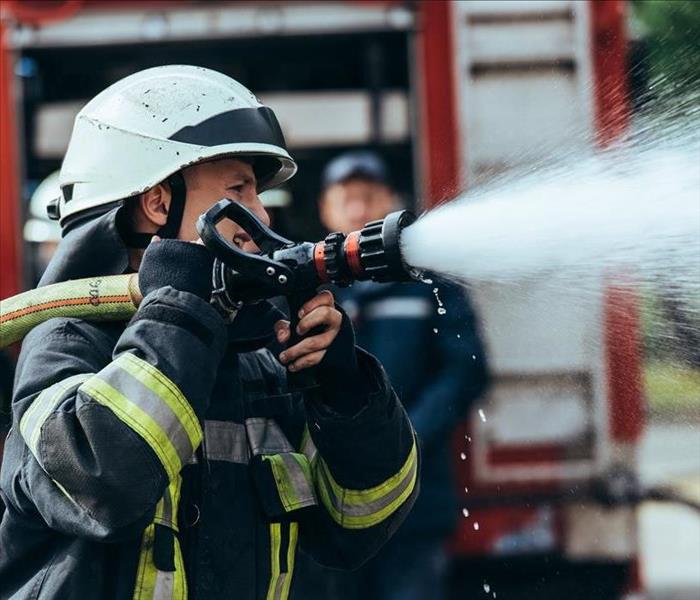 Call a restoration team to repair your home after a fire in Pueblo, CO.
Call a restoration team to repair your home after a fire in Pueblo, CO.
The flames in a house fire can destroy a lot of your home in Pueblo, CO, in a very short amount of time. Important documents, furniture, clothing, and even the structure itself are likely to sustain fire damage. To further complicate matters, the water that firefighters use to put out the fire can also destroy parts of your home. Full mitigation involves addressing both types of damage to make your house whole again.
Steps That Fire Restoration Specialists Must Take.
Assess Fire Damage
When the cleanup team arrives, the first action step is to map out the rest of the process. The members of the team look at several factors:
- The extent of the damage
- Size of the affected area
- Time passed since the fire
- Number of belongings involved
All of these factors impact not only how much work needs to be done but also the timeline for completing it. This information, in turn, dictates how much the cleanup process is likely to cost. You may not be able to control all the factors, but the sooner you call for help, the more likely it is that technicians will be able to stop ongoing damage in its tracks.
Remove Excess Moisture
To take care of the water damage, all standing water must be removed from your house. This step occurs early in the process to help prevent secondary damage such as rot or mold growth. After industrial pumps extract water and debris, technicians can get a better look at the problems they left behind.
Tear Out Ruined Materials
No matter how quickly the flames are put out, they still leave behind quite a bit of fire damage. All ruined materials, including flooring, ceiling, walls, insulation, roof materials, and support beams, must be torn out. Technicians conduct this process methodically so that they don't compromise more of the structural integrity of the house.
Clean and Dry Remaining Structure
Once the water from the fire hose hits the flames and the burning structure, it is contaminated, which means everything that it touches must be disinfected. The mitigation team cleans the remaining parts of the house, getting rid of bacteria as well as soot and smoke damage. Then the entire space must be dried thoroughly.
Determine Salvageability of Belongings
Items that were removed along with ruined materials meet one of two fates. They are either cleaned so that they can be returned to your home, or they are discarded. Remediation experts have the training and experience not only to determine which items can be salvaged but also to clean them properly so that they are safe to use.
Restore Home
The final step of the mitigation process is restoring your home to its former glory. The technicians rebuild the structure and make sure the tile, paint, and wallpaper all have seamless finishes. The job isn't finished until your house is ready for you to move back in.
Taking care of the fire damage to your home is just one part of the restoration process. Understanding the importance of each step helps you set clear expectations for cleanup.
Fall and Fire Risk: What You Should Know | SERVPRO® of Pueblo
9/21/2021 (Permalink)
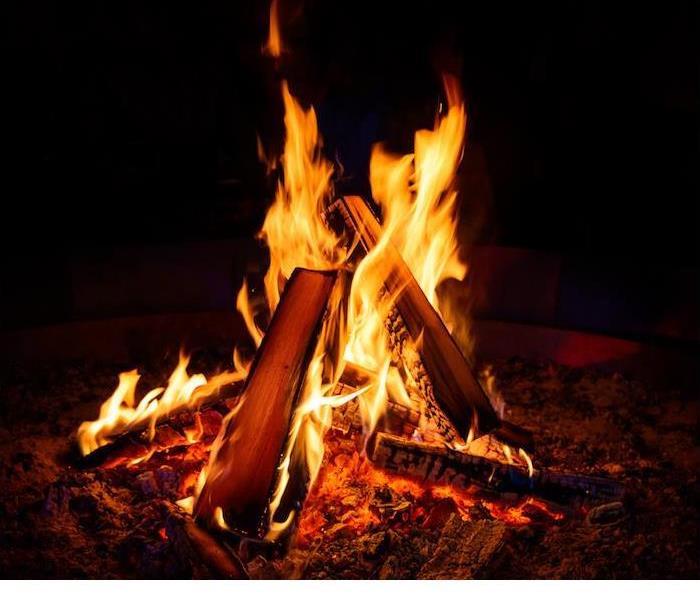 Be mindful about fall fire safety. Always remember that SERVPRO of Pueblo is the trusted leader in the restoration industry.
Be mindful about fall fire safety. Always remember that SERVPRO of Pueblo is the trusted leader in the restoration industry.
While we still have a ways to go, the evenings are starting to bring about the crisp fall air. Fall is a favorite, especially in our neck of the woods. Hiking, camping and other outdoor activities become much more enjoyable.
Like any other season, though, fall brings dangers or hazards that we need a gentle reminder about. So, as you put on your warm slippers at the end of the day, take a quick glance at these seasonal safety tips.
Campfire Safety
Campfires can be the perfect ambiance to any activity, but it’s essential to know where and how to build it, as well as how to put it out. When you are prepping to start a campfire, you should be sure to use dry leaves, twigs or branches.
When you are ready to start the fire, it’s best to use a match or lighter, and never use an accelerant like kerosene or lighter fluid. A good thing to remember is to keep a safe distance between your campfire and anything else that can easily catch fire.
And last but not least, before heading in for the night, make certain that you have extinguished your fire completely before leaving the fire. You can always (slowly) douse your fire with water to ensure that the embers are completely drenched.
Space Heaters
As we know, here in Pueblo it can easily go from crisp air to quite chilly. This is when a space heater can become quite handy.
Portable space heaters, while handy, are also one of the most frequent causes of home fires. Anytime you use a space heater, it’s imperative that you keep it up and away from anything flammable.
Nowadays, many space heaters come with an automatic shutoff capability, which ensures that if your space heater overheats or falls over it will automatically shut off. This reduces the risk of fire tremendously. While this feature can be very helpful, it’s also smart to make sure you keep the space heater up and away from kids or high traffic areas.
Halloween
While it’s still a few weeks away, we all know that a lot of us look forward to decorating our homes or porches for the fall season.
We’ll go into depth about specific holidays later, but be aware that all decor and costumes can cause a serious fire hazard. It’s important to stay aware and attentive to things in and around your home.
If a fire hazard should turn from potential to reality in your home, remember the trusted leader in the recovery industry and contact SERVPRO to get your property fully restored right down to the smell of smoke.
Causes of Water Damage in Your Home | SERVPRO® of Pueblo
9/7/2021 (Permalink)
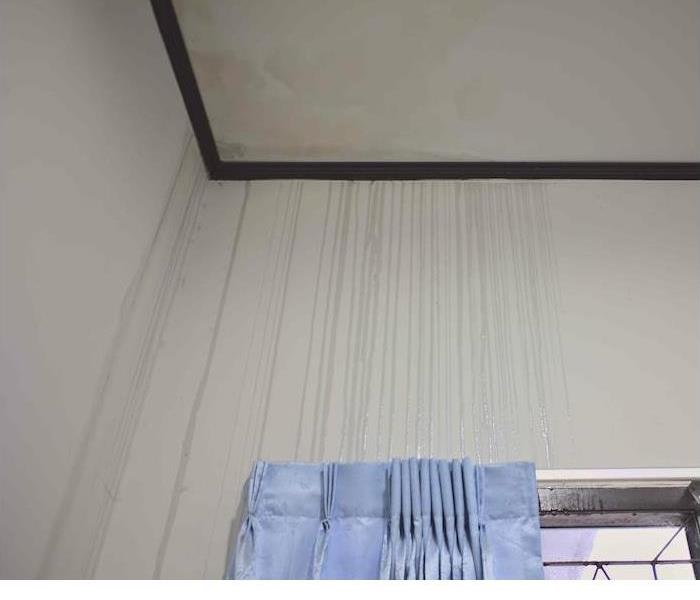 A water leak can turn into a big problem. Contact the SERVPRO of Pueblo team if you are dealing with any water damage.
A water leak can turn into a big problem. Contact the SERVPRO of Pueblo team if you are dealing with any water damage.
When you have water damage in your home, your mind starts racing and you have no idea where to begin with the cleanup. With water, it seems that it can always find its way into your home, through any open crack or crevice.
Being prepared can save you both time and money in the long run. By being proactive and prepping your home or staying on top of maintenance, you can possibly reduce your risk of being affected.
Let’s look at some common causes water damage—in other words, where you should look!
Toilets. Toilets can easily leak or overflow, and that can be quite disgusting. Beyond the ick factor, whether it results from problems with the toilet seals or cracks in the tank or pipes, the water damage can be quite substantial.
Appliances. These luxury items, like dishwashers and washing machines, help make our world a little easier to live in. But like most things, it doesn’t come without a chance of problems. Because many appliances need a source of water, it’s common for them to leak. This often occurs because of the corrosion that can occur on metal items. With a water heater, this degrading of metal can even cause an explosion.
HVAC units. AC is an essential in many parts of the country during the steamy summer months. But the AC can also spring leaks. It’s important to have it inspected and cleaned on a regular basis.
Pipes. When it comes to the plumbing in your home, what can seem like a small leak can quickly turn into a flooding of your home. Whether it’s from old pipes that finally gave way or weather that has caused your pipes to thaw or bust, the water damage can start in your walls without you ever even knowing it. Tree roots are also a common cause of pipe problems that develop into leaks.
Clogged gutters. Gutters perform an essential function, helping water drain efficiently from the roof of your home, which can help prevent leaks in the ceiling or walls. Inspect the gutters regularly and after storms, and remove any debris found inside to clear a pathway for water.
Maintaining your appliances, roof or pipes can not only help protect your home from disasters, but it will also help your things have a longer life. Some simple actions can save some big money.
If a water leak erupts into a big problem at home, you’ve got the best team in the business on your side. Contact SERVPRO today so we can get started.
What to Know About Summer Storms | SERVPRO® of Pueblo
8/17/2021 (Permalink)
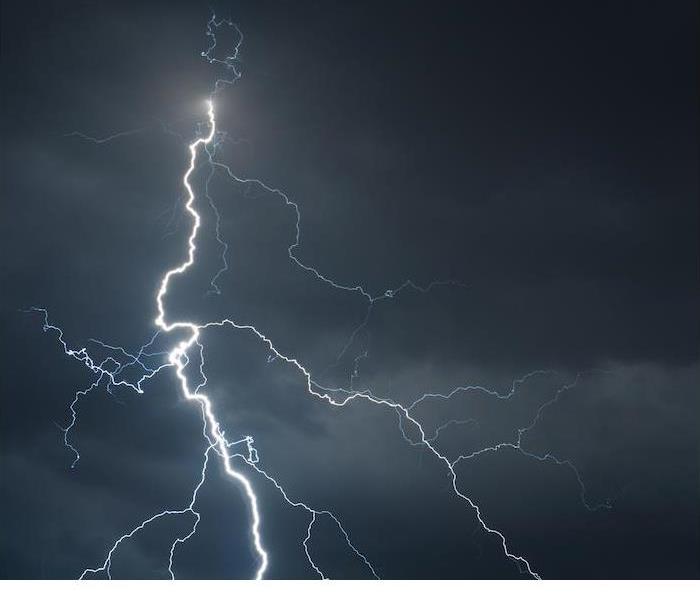 If storms cause damage to your home or business, SERVPRO of Pueblo is on the line, ready to make things right.
If storms cause damage to your home or business, SERVPRO of Pueblo is on the line, ready to make things right.
Sweet summertime always reminds us of family events, mostly outdoors!
It may also seem that summer can bring more thunderstorms than any other time of the year, and it’s totally true. In most parts of the country, there are atmospheric conditions that create moisture and warm air, which helps create thunderstorms.
Here in Pueblo, from mid-July to mid-August, the rain chances double.
Alert and Aware
While thunderstorms are quite common for almost every place, they should never be taken lightly. Make sure you’re always aware and prepared by getting storm alerts or making other arrangements for outdoor activities.
In case you lose power, it might be smart to purchase an NOAA Weather radio so that you can receive weather alerts.
Flooding is rarely predictable and always possible.
You should make preparations to stay off the roads. “Turn around don’t drown” is a common saying because water along the roads can easily sweep your car off the road.
Dozens of people die every year because of storm-related accidents. Never ignore a simple thunderstorm, because it can easily become dangerous without much warning.
Playing It Safe
If lighting presents itself, stay indoors. It’s not safe to go back outside until you haven’t heard thunder in at least a half hour.
During these stormy events, stay away from windows and avoid bathing or showering.
Here in Pueblo, we get a lot of flash flood warnings or watches, so it’s smart to keep an emergency kit prepared and ensure that you know the evacuation route for your area.
If flooding occurs, make sure to stay off the roads, by vehicle or foot. Flood waters can present many dangers, either sweeping your car away or causing electrical issues.
There are any number of dangers that can come into play in a thunderstorm, and it’s always best to be cautious and put things on hold until storms safely pass. If storms cause damage to your home or business, SERVPRO is on the line, ready to make things right again.
The Services You Need, Right When You Need Them | SERVPRO® of Pueblo
8/17/2021 (Permalink)
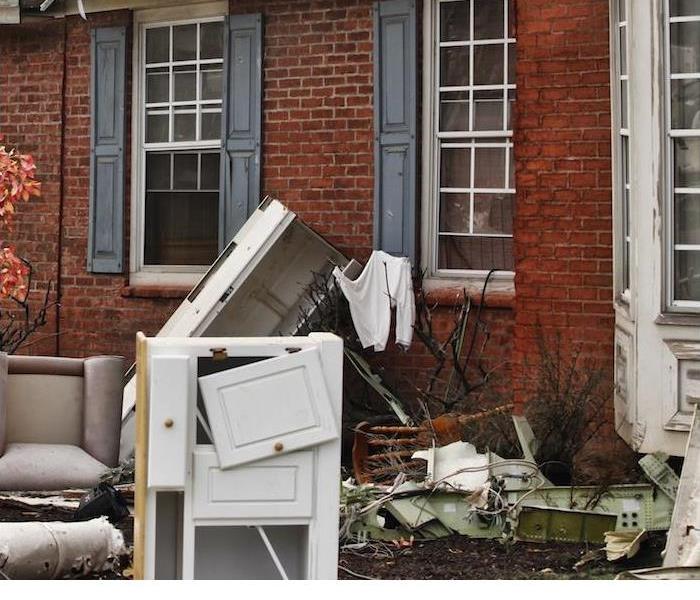 When you are dealing with any damage, immediate action is crucial. SERVPRO of Pueblo is your local restoration expert.
When you are dealing with any damage, immediate action is crucial. SERVPRO of Pueblo is your local restoration expert.
Most of us, at home or work, work hard to make sure things go smoothly. The smoother things are, the better the morale for everyone. And as we all know, this is not an easy task.
So, if disaster strikes, keeping things running smoothly seems to go out the window. You become more focused on the new emergency at hand, and this affects everyone in what could be a negative way.
Here at SERVPRO, we are equipped to help take the pressure off you. Disaster recovery is what we excel in.
The easiest decision you can make for yourself is to hire us, and here’s why:
We’re Always Available
We are here to answer your call 24 hours a day, seven days a week in case you or anyone else calls and needs assistance. When disaster strikes, time is not your friend.
When disasters happen, we are ready and waiting for you to call.
We Offer a Fast Response
Being in the disaster recovery industry, we know better than anyone that when disaster hits, every second counts.
For every second that accrues, there is a chance of more mold growth or the need for additional costly repairs. A fast response is crucial, and we are locally owned and operated so that we can reach our Pueblo customers quickly.
We’re Trained for Both Home & Business Restoration
When disaster strikes, we’re prepared to help. Our technicians have undergone extensive training to handle the unique needs and challenges of both commercial and residential restoration.
We Evolve When Needed
Since the outbreak of COVID-19, disease prevention has become a top priority for everyone, especially business owners. Because of that, we now offer a cleaning service that is certified and goes above and beyond traditional janitorial services.
It’s now essential to let your customers know that your business is clean and sterilized. That’s why we make it our job to offer you peace of mind with a hyper-clean space for your employees and customers.
So when disaster strikes, no matter the cause or the size, you know you have SERVPRO on your side ready to make everything “Like it never even happened.”
Regardless of the what, where or why, SERVPRO has the tools, technicians and training to get your situation under control. When you’re ready to let us tackle the hard stuff, get in touch with SERVPRO of Pueblo.
Understanding Wildfires & Defensible Space | SERVPRO® of Pueblo
7/26/2021 (Permalink)
 If your home is damaged by fire or any other reason, SERVPRO of Pueblo is ready and able to repair any damage.
If your home is damaged by fire or any other reason, SERVPRO of Pueblo is ready and able to repair any damage.
Did you know that wildfires are a more common cause of property damage than you are led to believe? Wildfires can spread at incredible rates, and it’s in part because of the combustible materials our world is made up of.
There are many steps you can take to help protect your property from wildfire, and one key step is as simple as being more careful. But defensible space is also a good strategy.
Let’s Talk About Defensible Space
If you’re like most, you can’t help but wonder what “defensible space” is. Well, it’s a buffer area you can create around your home by removing potential wildfire fuel, including things like dead trees and leaves. You can also add a layer of protection with things like flame-resistant gravel landscape close to your home.
Defensible space is essentially an invisible barrier of protection, designed to protect your home from wildfires, either by slowing or stopping the spread of fire as it draws nearer. This defensible space also gives firefighters their best chance of stopping a wildfire before it reaches your home.
Defensible space is so important that some states require you have it. Our state doesn’t require it, but it’s still a good idea to practice.
Wildfires Are on the Rise
When thinking of wildfires, we often see California as the main culprit, but wildfires can happen anywhere. There were over 59,000 wildfires across the United States in 2020.
Even if you take California out of the mix, the average number of wildfires per state in 2020 was right under 1,000. Here in Colorado, we had 1,080 wildfires last year, burning 625,357 acres of land.
In Pueblo, we see our fair share of wildfires, so it’s essential that we do everything we can to help prevent them. Defensible space is one way that we can do our part.
If your home is damaged by fire of any sort, wild or not, SERVPRO is ready and able to repair the damage caused. Get in touch today to get the pros on your team.
The Impact of Severe Weather | SERVPRO® of Pueblo
7/8/2021 (Permalink)
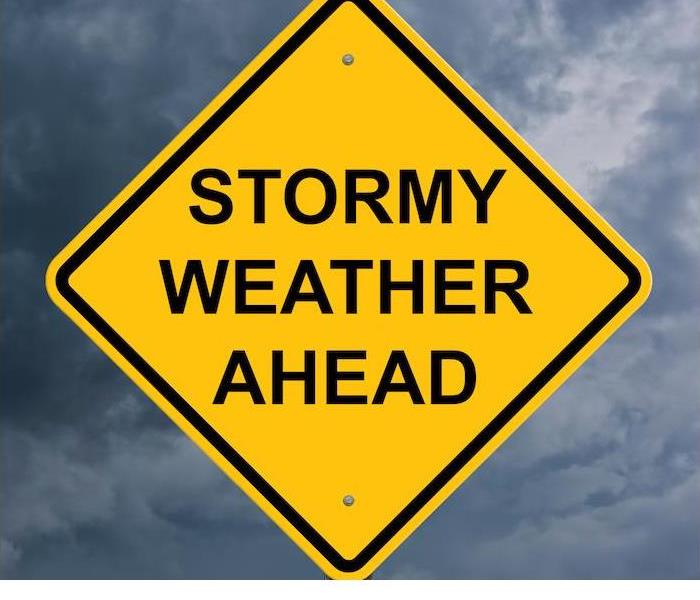 When storms do damage, we go to work to make things right. Contact SERVPRO of Pueblo to start the restoration process.
When storms do damage, we go to work to make things right. Contact SERVPRO of Pueblo to start the restoration process.
The year 2020 will be one for the books to say the least. In addition to the drama that ensued, it was also a record-setting year for weather and climate disasters. Of all the years in history for which we have data, 2020 was the most financially destructive.
During 2020, there were 22 official weather disasters, which are defined as events that cause at least a billion dollars in damages.
There were also many other damaging storms that weren’t accounted for in that statistic. In fact, there were so many named hurricanes and tropical storms that for only the second time in history, the NWS had to dip into the Greek alphabet just to be able to name them all.
Just How Severe Are We Talking?
Hurricanes can do some mass destruction and in turn cost large monetary amounts in damages, but crazily enough, it’s not only the hurricanes that are doing this.
In fact, the most expensive disasters of 2020 in the contiguous United States were thunderstorms and tornadoes.
In 2020, it was reported that 14 of the official weather disasters were severe thunderstorms, and some of which unleased ravaging tornadoes as well. Thunderstorms don’t discriminate, they happen anywhere and during all seasons of the year.
In Nebraska in August 2020, a single storm system became extremely damaging. A seemingly typical line of thunderstorms exploded into a derecho (something like a tornado but with straight-line winds instead of swirling ones) and impacted more than 10 million acres of corn fields, that’s over 11% of the entire country’s corn fields.
In Pueblo, hail and flooding are no strangers to the area. People often talk about the storm that “reshaped Pueblo.” In early June 1921, torrential rains swelled the Arkansas River to a mile wide and 15 feet deep in some places. There was talk that the death toll took many lives, including telephone operators who stayed at work to send out warnings.
Is This the New Normal?
When it comes to weather nowadays, it seems that 2020 hasn’t really been an outlier, but in fact it’s becoming the new normal.
2020 was the 10th consecutive year with at least eight billion-dollar disasters. For 2018 and 2019, we saw a combined total of $136 billion in damages, and in 2017, the damage total was over $300 billion.
Storms are normal—what’s changed is that their frequency and intensity are showing no signs of diminishing. That’s why as a home or business owner it’s important to take whatever precautions are possible.
No matter the precautions you take, it’s important to know that things are beyond your control at times. So remember you’ve got a friend in the restoration industry whose goal is to recover your valued items and restore your property "Like it never even happened."
When storms do damage, we go to work to make things right. Contact SERVPRO today to see how we can help.
The Level of Clean Your Customers Now Expect | SERVPRO® of Pueblo
6/21/2021 (Permalink)
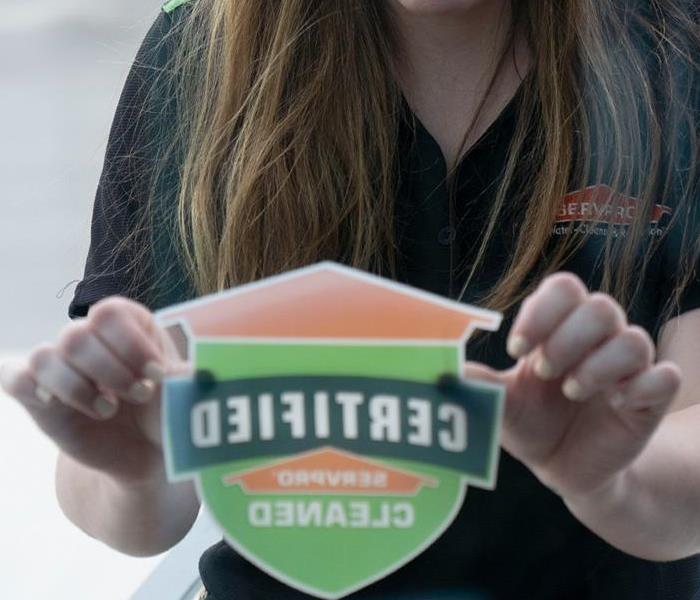 If you’re business has sanitation and cleaning needs, reach out to the SERVPRO of Pueblo team.
If you’re business has sanitation and cleaning needs, reach out to the SERVPRO of Pueblo team.
Hope is on the horizon! After a year and a half of chaos, we’re now seeing positive signs of recovery. Areas that were previously COVID-19 hotspots are now experiencing major turnarounds.
As more and more customers return to in-person shopping and other activities, they will bring with them new expectations. We’re all now more aware of how fragile our health can be—and we will expect businesses to demonstrate that our wellness and safety are important.
How can you show your customers that you prioritize their health? Start with a Certified: SERVPRO Cleaned.
How Does Certified: SERVPRO Cleaned Work?
We created SERVPRO’s enhanced cleaning program for multiple reasons. One was to take the stress and pressure of advanced cleaning and sanitation off your plate.
There’s an added benefit of trusting our experts to clean your business. We stay “in the know” about what’s needed to keep things disinfected and sanitized. SERVPRO uses advanced biohazard techniques and technologies that go well beyond your traditional cleaning and janitorial services.
Let’s take a look at the three C’s of a Certified: SERVPRO Cleaned:
Consult. Step one is for a SERVPRO specialist to visit with you and learn about the unique needs of your business. This includes factors related to the size of your business, the work you do and who spends time in the facility. Since SERVPRO of Pueblo is locally owned and operated, we know many of the particulars about area-specific needs and guidelines.
Clean. Once your unique needs have been established, our SERVPRO technicians show up on site with proprietary, hospital-grade cleaning solutions you won’t find anywhere else. These solutions meet (or exceed) the CDC standards, and help protect those working at and visiting your business from not only COVID-19 but also conditions such as the common cold and the flu.
Certify. Once our technicians have completed your cleaning, you can proudly display the Certified: SERVPRO Cleaned shield on your business window. This emblem shows customers that you have care about their well-being. You’ll also get digital emblems and other signifiers to place on your website and social media, letting customers know you maintain a high level of clean before they ever enter your doors.
If you’re ready to get serious about sanitation and have your business Certified: SERVPRO Cleaned, get in touch today to get the best team in cleanup and restoration on your side.
Sunrise, Sunset & Fire Safety | SERVPRO® of Pueblo
6/7/2021 (Permalink)
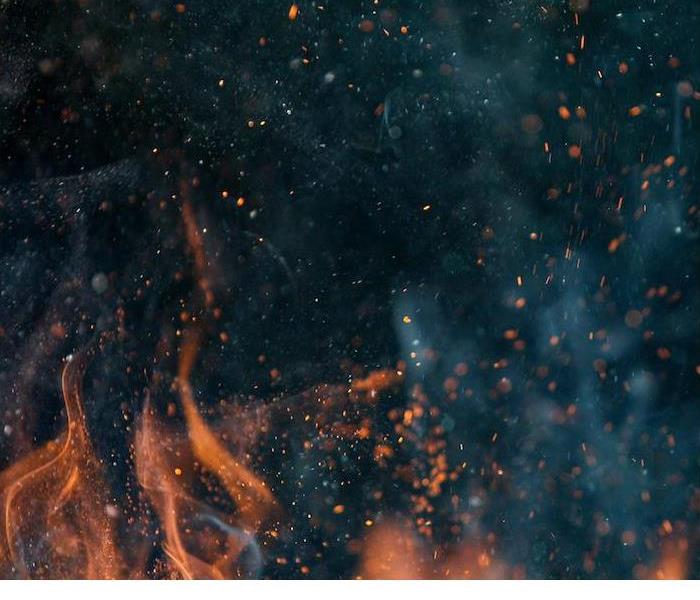 Restoring fire and smoke damage is one of our specialties. Contact SERVPRO of Pueblo to learn more.
Restoring fire and smoke damage is one of our specialties. Contact SERVPRO of Pueblo to learn more.
The warmer months offer us cookouts, seasonal celebrations and so much more. But when doing these fun things, do you focus on safety? Let’s look ahead and see what we can do in order to be proactive!
It’s a fact that the warmer months bring a higher risk of safety hazards. In fact, spring sees more daily fires on average than any other time of the year.
Do you know the risk that your home, or lifestyle, offers? Let’s take a look at the most common fire risk and what you can do to prepare:
BBQ & Cookouts
Barbecuing, cookouts, roasting marshmallows…all fun and necessary for those warmer months…but they can also be risky! Grilling provides a combination of flame, heat, grease and gas, causing it to lead to danger pretty easily. The best thing you can do before grilling is a quick check to make sure everything is in good working condition, make sure it’s away from anything flammable and be sure the grill has been cleaned. While cleaning in between uses seems to be common sense, almost 20% of grill fires are caused by improper cleaning.
Fire Pits
Fire pits, a blanket, kids and marshmallows: Every bit of that says summer! But you can become so enthralled with the beauty of the fire, along with the fun it provides, that you might let safety slip your mind. Make sure you never leave kids unattended around a fire pit, and that you always keep a bucket of water close to the pit.
Chimneys & Dryer Vents
Fireplaces are a focal point in many homes. And while fires make for great scenery as you enjoy friends and family, it is also important to make sure you get the chimney inspected every year. A buildup of ashes can cause some serious damage. In addition, your dryer vents can become clogged with lint and debris, so take the time to clean the pipes while you’re spring-cleaning.
Your local SERVPRO technicians are on hand 24⁄7 for emergencies. If you encounter fire damage at your home or business, no matter the cause, we will be there faster and have it cleaned up sooner. Call or click today and experience the SERVPRO difference.
Common Indicators of Basement Water Damage | SERVPRO® of Pueblo
5/21/2021 (Permalink)
 SERVPRO of Pueblo is a full restoration company. Our team of experts are on call and ready to help you determine the best course of action.
SERVPRO of Pueblo is a full restoration company. Our team of experts are on call and ready to help you determine the best course of action.
The basement is a favorite room of the house for many homeowners and families. It can be spacious for storage, cozy for living or playing or safe for sheltering in a storm.
But because basements are dug into the soil around your home, they often fall prey to moisture leakage, not to mention they become the fall-guy areas for other leaks in the home from plumbing, water heaters and the like.
While there’s certainly no guarantee that you’ll have to deal with water damage in your lower level, the odds are high enough that you should definitely be aware of what to look for. These indicators will let you know that water is coming in from somewhere—and when you see them, your local SERVPRO technicians are awaiting your call.
The Top Indicators of Water Damage in a Basement
Unpleasant, musky odors. Even if water that gets into the basement is clean, whether it comes from rainfall or a burst pipe, it doesn’t take long for it to develop bacteria, which turns into mold on your home surfaces and emits the musty, malodorous smell often associated with basements. This smell shouldn’t be the norm—it only arises when mold and mildew are present in the environment, and even if you can’t yet see mold, the smell lets you know you’ve got a water issue to manage.
Flaking paint on masonry or walls. Homeowners sometimes apply so-labeled waterproof paint to their basement interiors, thinking its one-application solution to lock out moisture. While it can help for a while, if a leak is happening behind it, even the thickest paint is going to eventually give way and let the water through. When you see bubbling, cracking and flaking in your paint job, there’s water to be found somewhere.
Foundational cracks. Homes may shift over time, but a crack in the foundation can’t be ignored, and it may be indicative of a serious water leak. On the inside, cracks may show up in the floor, the ceiling or in your walls, telling you that your house’s frame may be succumbing to undue pressure caused by a cracked foundation. There’s no need to worry about minute, hairline-type cracks, but anything larger requires professional help.
If you notice any of these signs in your basement, let us take a look. Our expert water restoration technicians can help you determine what is causing these issues and how to treat it properly. Contact us today to learn more.
Copyright © 2021 SERVPRO of Pueblo
Take the Right Steps to Stop Rain From Damaging Your Home | SERVPRO® of Pueblo
4/5/2021 (Permalink)
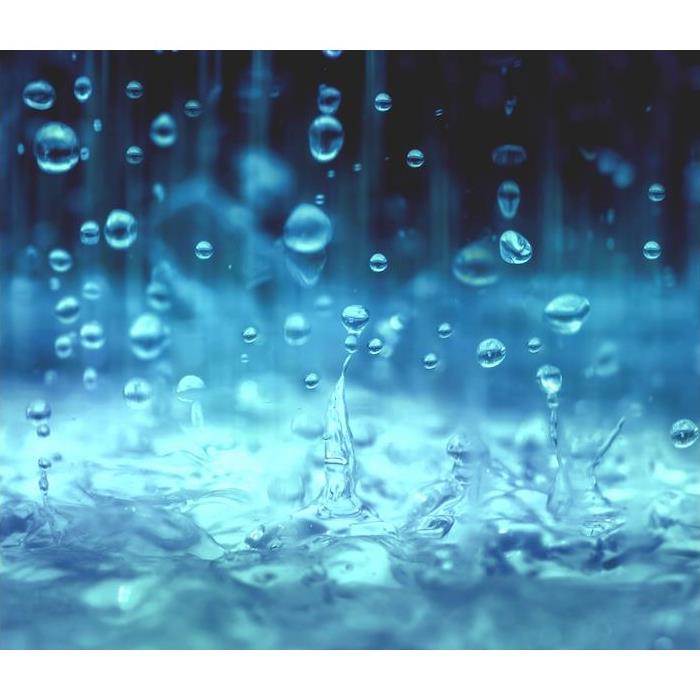 If you need help dealing with any damage caused by water, contact SERVPRO of Pueblo today.
If you need help dealing with any damage caused by water, contact SERVPRO of Pueblo today.
If you were asked about the most common reasons homeowners had to file water damage claims on their insurance, what would you say?
The most common guesses include damage from storms or floods. Right behind those causes are problems with items in the home, like the plumbing or the sewer.
The reality is that water damage can come from many places.
Homeowners cite a variety of problems when they file water damage claims, including things like severe floods and storms or from problems in the home, like a burst pipe.
Just how common is water damage? Insurance industry experts speculate that as many as one in every 50 American homeowners will file a water damage claim this year.
So if you have to file a claim for water damage this year, you’ll have a lot of company. Statistically, it’s like that someone you know will have to file a water damage claim this year, too.
Preparing Your Home and Family for Wet Weather
Our staff includes a dedicated team of water damage experts, so we have valuable insights into how you can protect your home from suffering water damage now and in the future. The good news is that basic home maintenance can help you stay safe from water damage.
Spend time understanding how drainage can impact your yard. The next time it rains, take a look at your yard. If the water from the rainstorm is draining toward your home, you might have a problem. You might want to connect with a landscaping expert to look for ways to protect your yard.
Use your landscaping as an extra layer of protection. Protective landscaping is real, and you can get it closer to home than you might think. It’s smart to use native plants to add more water protection to your home. Talk to a local expert about native plants or visit a native plant sale.
Seal your roof. According to insurance industry statistics, 95% of damage is caused by water finding its way through gaps in your shingles, which can be prevented with this step. It’s definitely worth considering.
If you need help dealing with damage caused by water, fire or any other issue, we’re here to help you restore your home. We have crews who are available 24⁄7 in the event of an emergency. Contact us at any time to learn more about us and how we can help you restore your home to its original state.
Is Your Home Ready for Spring Thunderstorms? l SERVPRO® of Pueblo
3/3/2021 (Permalink)
 Is Your Home Ready for Spring Thunderstorms? l SERVPRO® of Pueblo
Is Your Home Ready for Spring Thunderstorms? l SERVPRO® of Pueblo
Are you ready for a new season? Most of us are!
As February turns to March, spring is definitely in the air. And many of us are starting to plan new projects and find different ways to brighten up a new season.
Maybe you’re an avid gardener planning your next landscaping project. Or maybe you’re looking for new ways to prepare old favorites on the grill.
Regardless of how you’re planning to spend spring, it’s a good idea to make time for home maintenance now, so you’re protected for one of spring’s weather threats—strong thunderstorms.
We can’t stop storms from hitting our homes and communities. But we can make sure our homes are as safe as possible when it happens.
Projects to Help You Keep Your Home Safe From Storms
It’s worth the effort to add these items to your seasonal to-do list:
Inspect your roof for issues. You want to be sure your roof is in good shape if a storm starts hitting. Check for things like missing shingles and signs of leaks. Repair them to keep your home safer.
Don’t leave items around your home unsecured, either. Don’t let unsecured furniture or other similar items become tools for wind damage. Trim back trees that need it and secure everything you can.
Don’t let tree limbs cause a problem. Tree limbs overhanging your home can fall during heavy winds. You can fix this issue, though. Cut down limbs or branches hanging over your garage and roof.
Ensure your sump pump is working (if you have one). Every homeowner doesn’t need one of these. But if you do need one to regulate water levels in your basement, it’s vital to keep it working. Be sure yours is in good shape before it starts raining.
Keep your gutters clean. This step is vital every season. Clean, clear channels are vital to keeping water around your home flowing the right way, instead of causing water damage.
If a fire, flood or any other cause damage to your home, you can always count on us for restoration assistance. We are available 24⁄7 in the event of an emergency. Contact us at any time to learn more about our restoration services and how we can help you.
Fire Safety Questions That Will Make Your Winter Safer | SERVPRO® of Pueblo
1/25/2021 (Permalink)
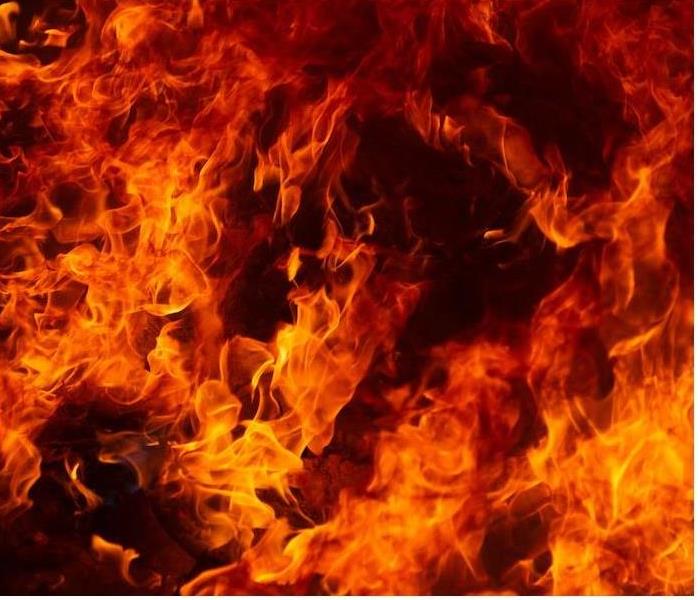 House fires trend to peak during the winter. SERVPRO of Pueblo are available 24/7 in the event of an emergency.
House fires trend to peak during the winter. SERVPRO of Pueblo are available 24/7 in the event of an emergency.
Did you know that house fires are more common during the winter months than at any other time during the year? House fires can indeed happen during any season, but they’re more common when it’s colder outside.
Experts estimate that every year about 890 Americans will die in a winter house fire. That number doesn’t include the people who will be injured or the homes and heirlooms lost to these tragic events.
Not every fire is preventable, but many winter house fires are caused by accidents and appliance failures that can be managed by taking some extra fire safety steps.
Do You Know the Answers to These Fire Safety Questions?
Your answers to these questions are a good place to start making your home safer:
Can you safely put out a grease fire? Grease fires are a common kitchen hazard, and thousands happen every year. Many people think water is the most logical way to put out a fire, but it makes grease fires worse. Instead, it would be best if you used a fire extinguisher, baking soda or a metal pan lid to smother the fire. (Cookie sheets can work, too.)
Are you cleaning the ashes out of your fireplace? Wood-burning fireplaces are a nice addition to a family living room. Use yours safely by ensuring you always have a screen covering it. Also, make sure you don’t let ashes and debris build up in your fireplace. Instead, dispose of the ashes correctly.
Are your candles in a safe spot? Many house fires every year are a result of poor candle safety. Candles may seem harmless, but they can start fires and should be used carefully. Please don’t leave them where kids or pets can knock them over. Never leave them burning when you’re not home.
If your home is damaged due to a fire or any other cause, you can always count on us for restoration assistance. We have crews who are available 24⁄7 in the event of an emergency. Contact us at any time to learn more about our restoration services and how we can help your family.
Signs to Look for When You’re Dealing With Water Damage | SERVPRO® of Pueblo
1/13/2021 (Permalink)
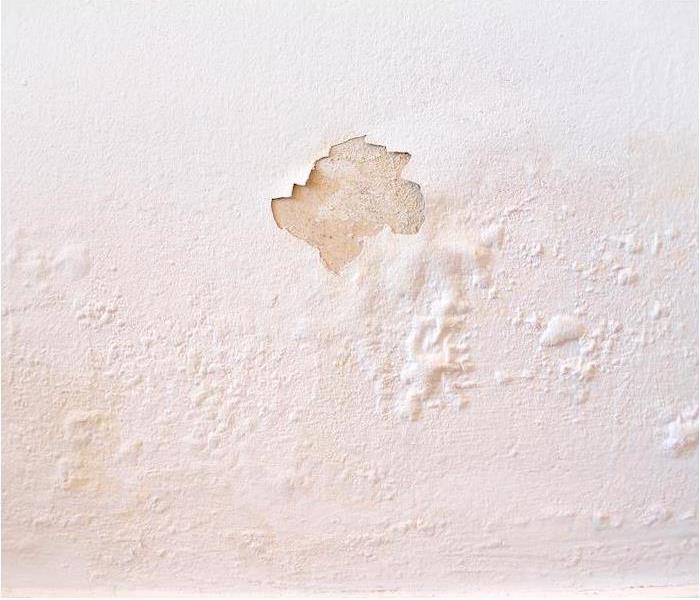 Do you have any water damage to your walls or ceiling? Contact SERVPRO of Pueblo, we will help guide you through the restoration process.
Do you have any water damage to your walls or ceiling? Contact SERVPRO of Pueblo, we will help guide you through the restoration process.
Water damage is a common headache for homeowners. In fact, one out of every 50 American homeowners files a water damage claim on their homes every year.
That’s not just because there are more of all types of claims being filed, either. Other types of claims have been falling in recent years. Water damage claims are growing annually, while claims for fire damage have been falling.
When to Consider Reaching Out for Help
If you’re an Avondale homeowner, you may be wondering when you could need water damage restoration help. Your local SERVPRO team can help answer your questions. And if you need restoration work, we can create a custom damage report for you.
You might notice these signs if you’re dealing with water damage that needs to be evaluated by water remediation specialists:
Fabric upholstery or curtains start to bleed or fade. Contact with water can cause certain fabrics to stain, bleed or fade. If you notice that happening to your drapes or your upholstered furniture, take notice. It can be a sign of water damage.
Wood in your home is starting to warp. Items made of wood can show damage from water only a few days after exposure. So timing is essential if you start to notice wood warping or staining. Call a water remediation technician immediately.
Signs of mold start becoming obvious. Musty odors are among the first signs of mold and mildew. So if you notice that distinctive scent, it’s important to move fast and begin the remediation process. Mold only worsens over time.
If you have water damage in your home due to a burst pipe or another cause, you can count on us for restoration assistance. We have teams who are available 24⁄7 in the event of an emergency. Contact us at any time to learn more about our restoration services.





 24/7 Emergency Service
24/7 Emergency Service






















































